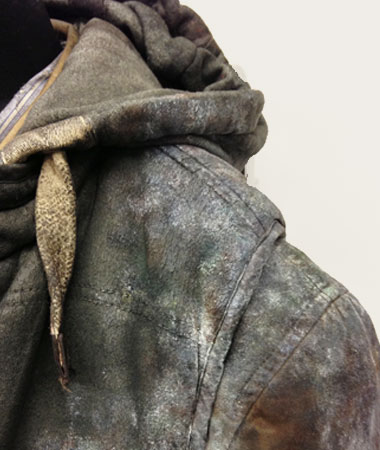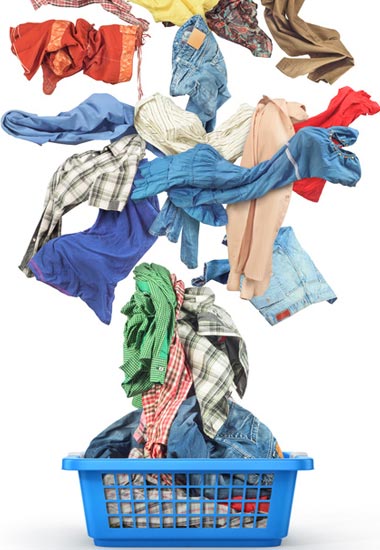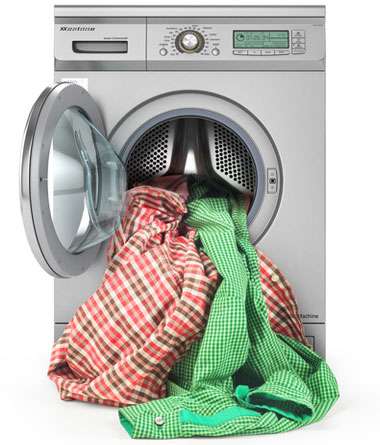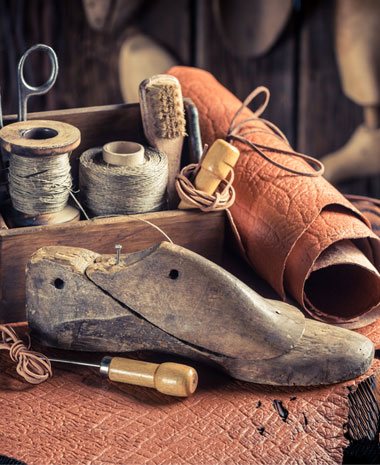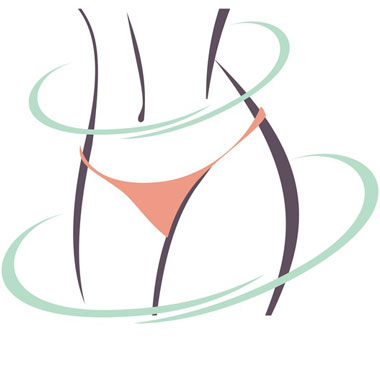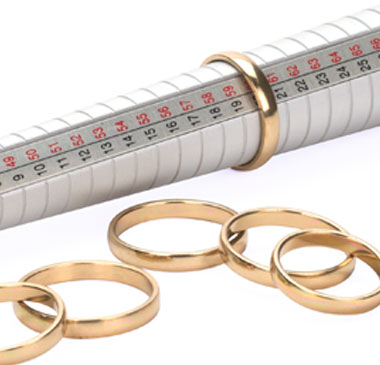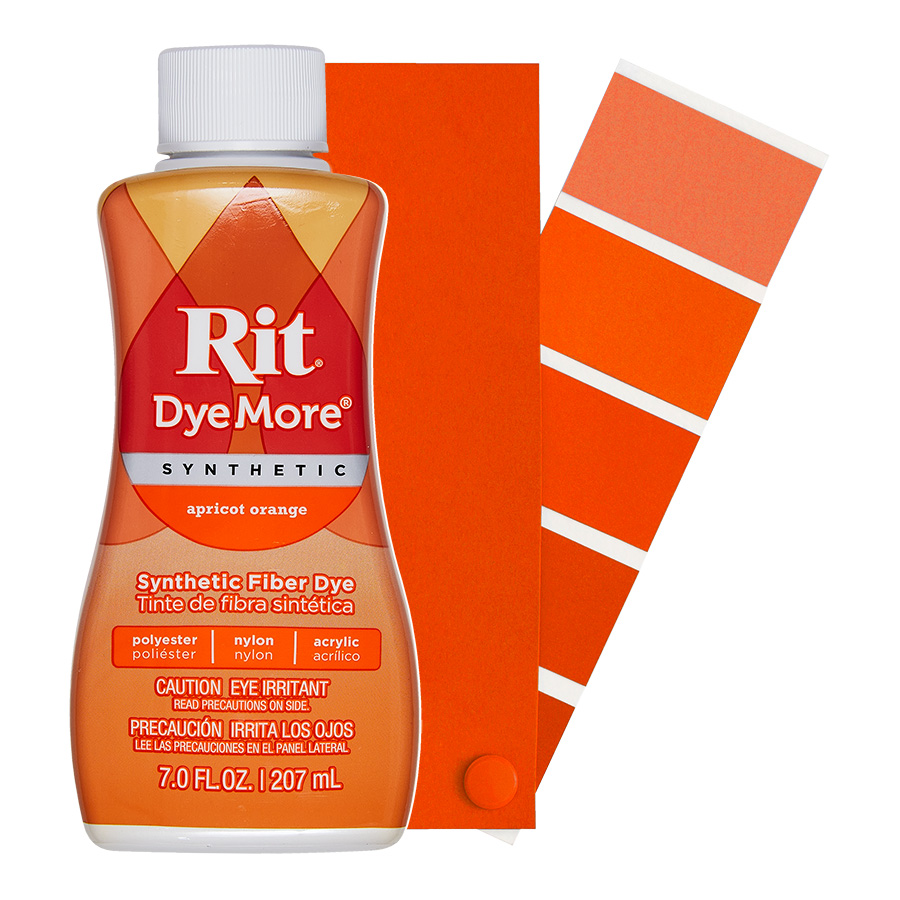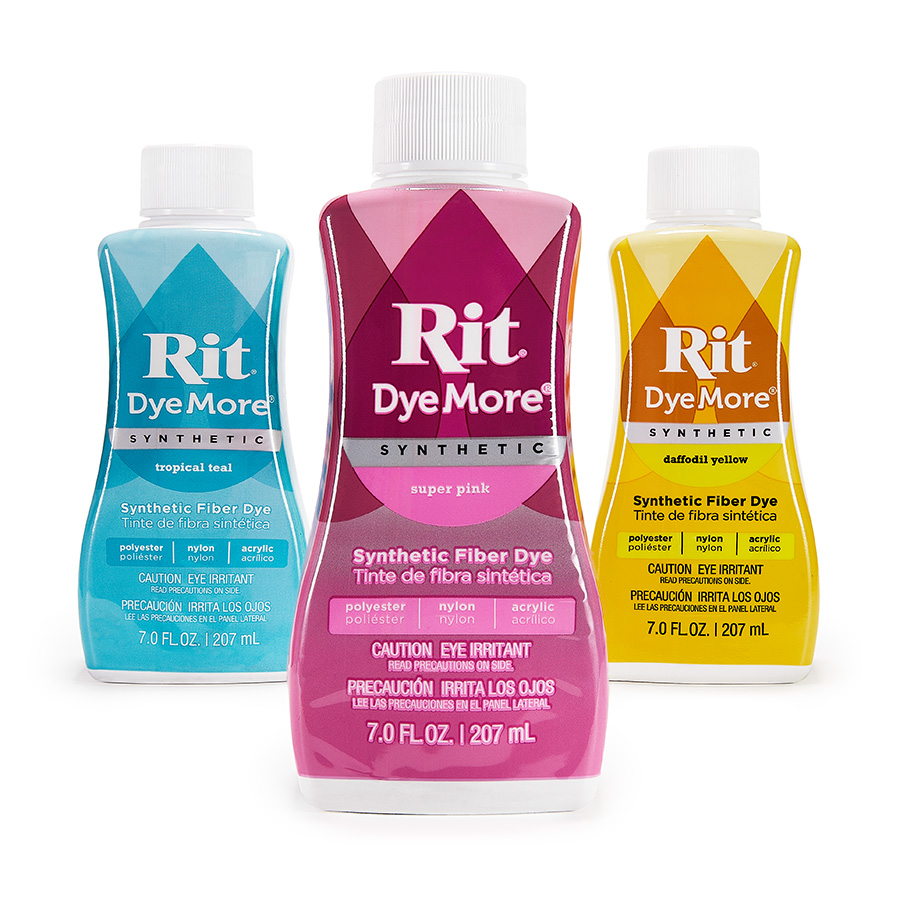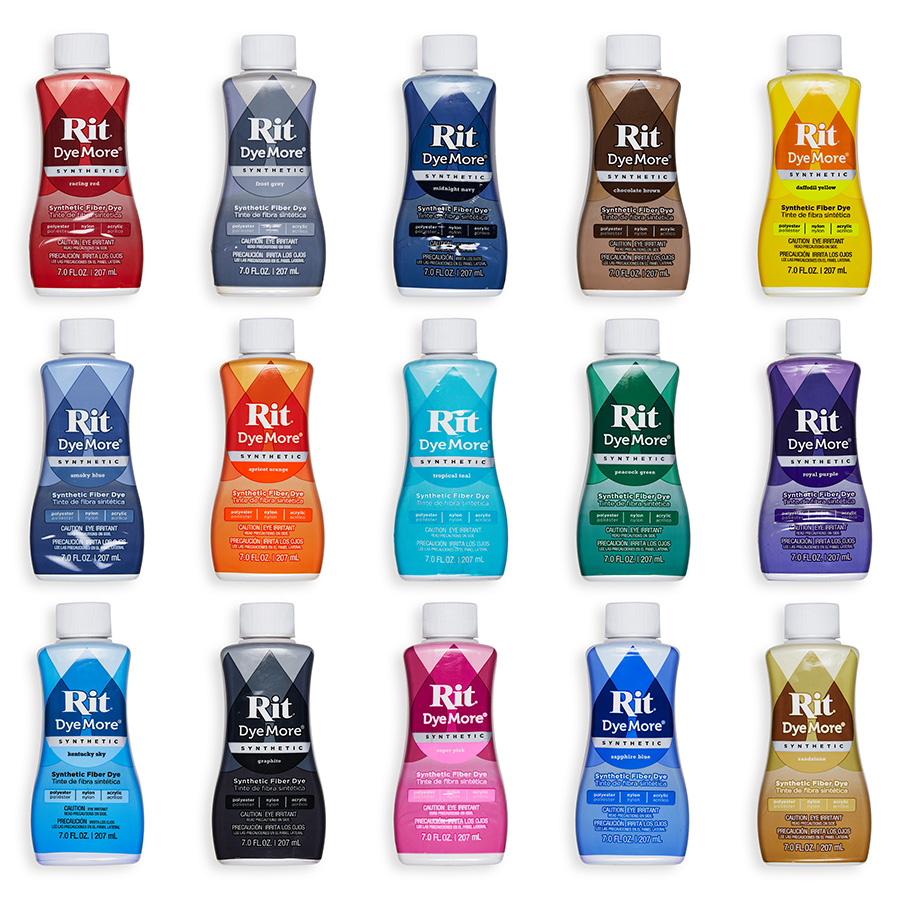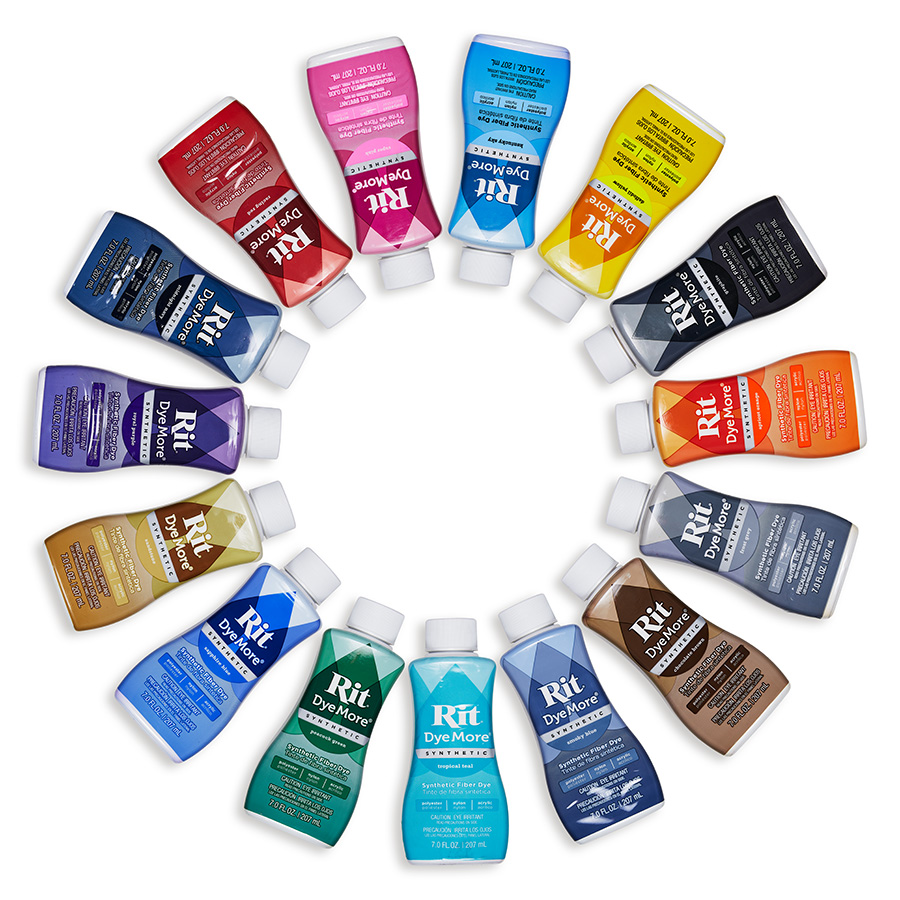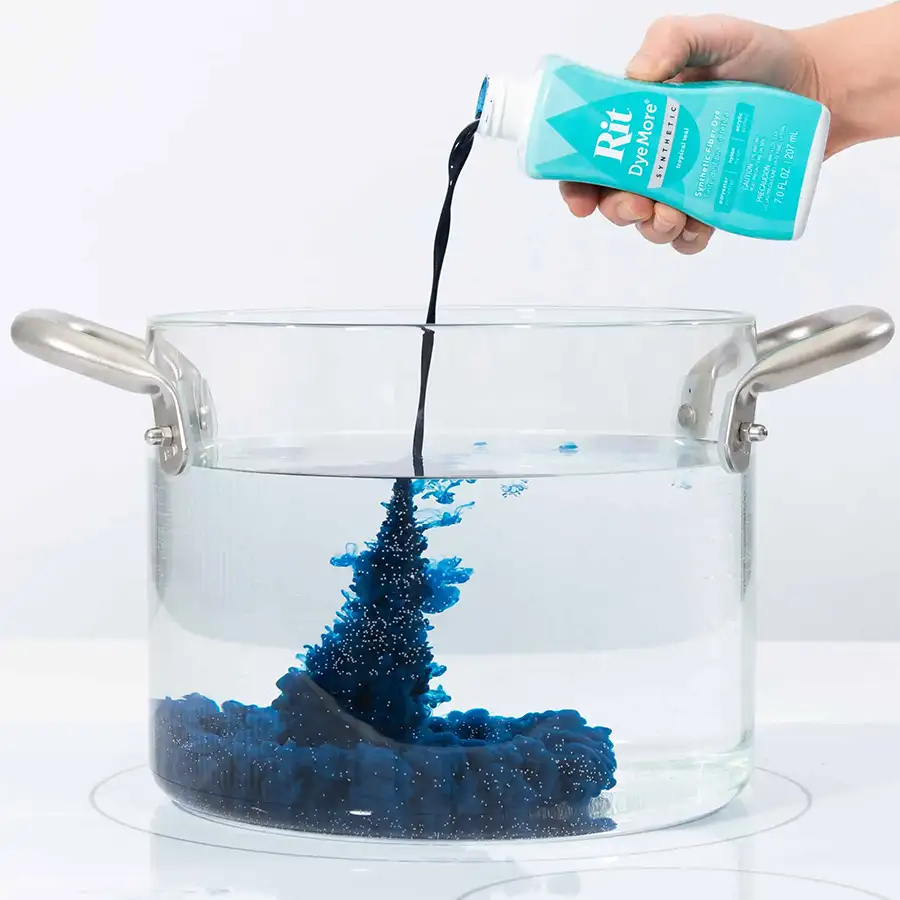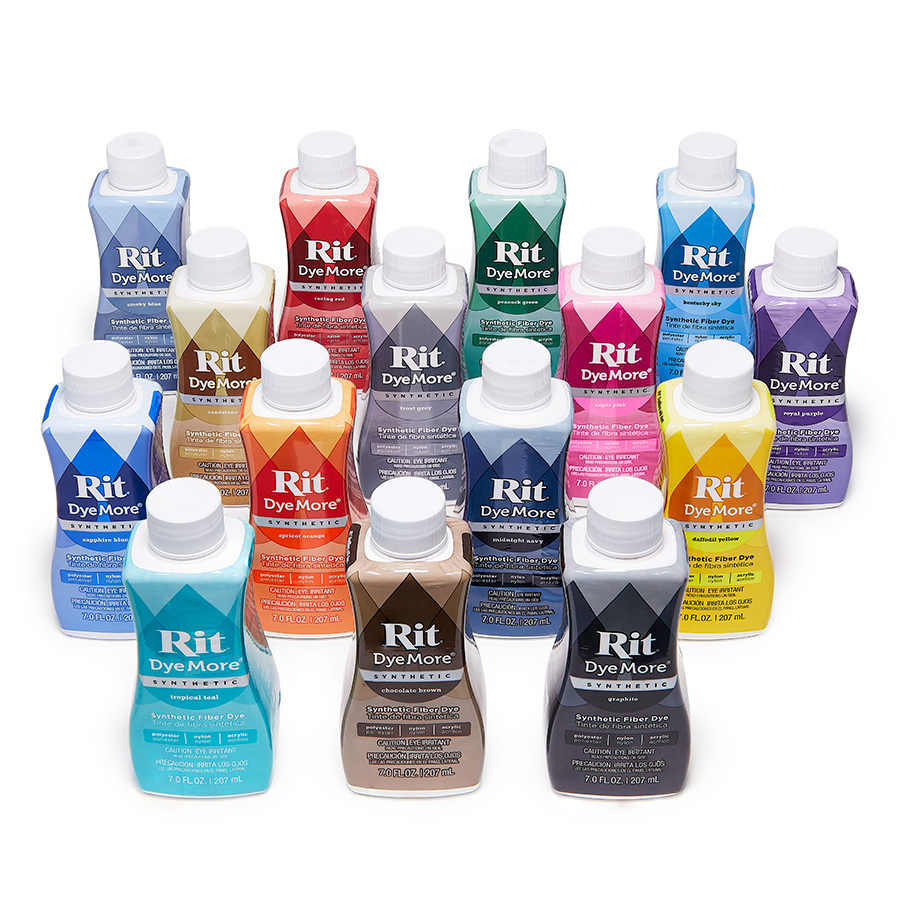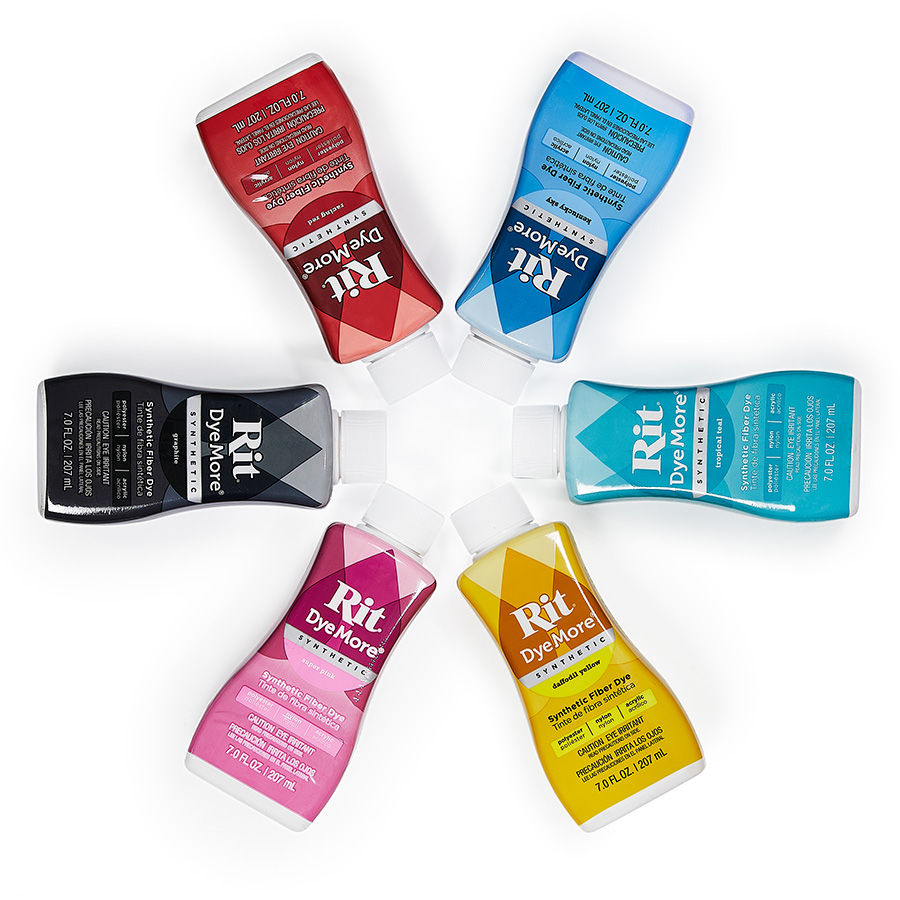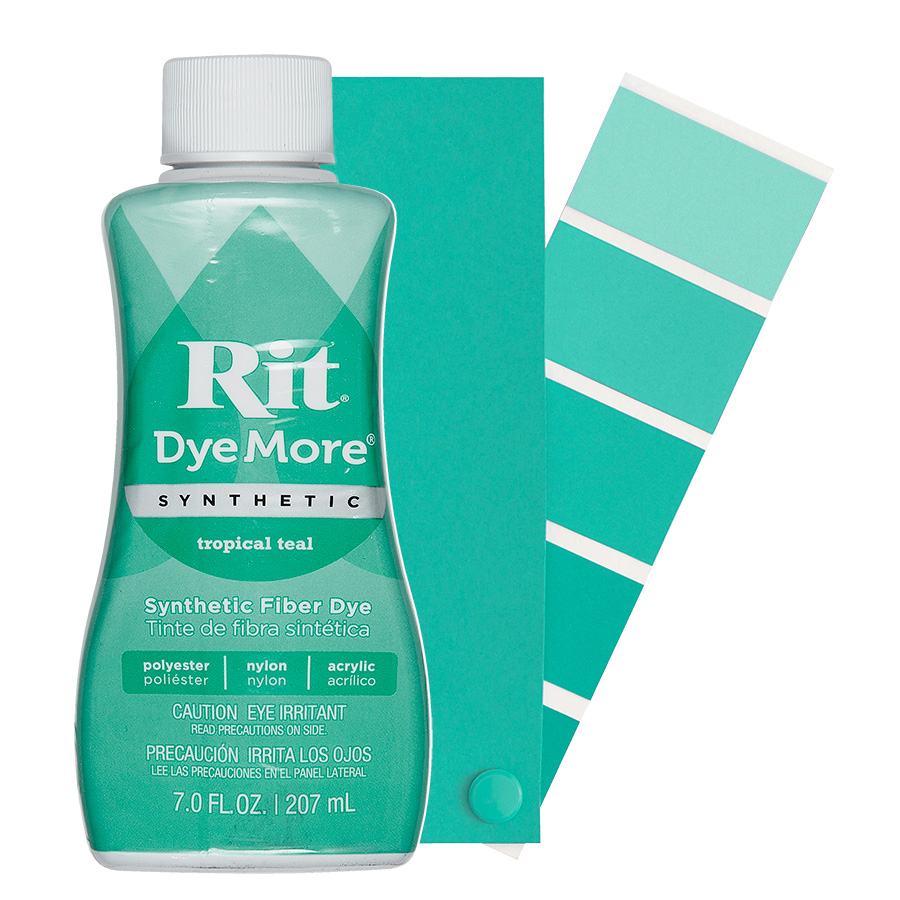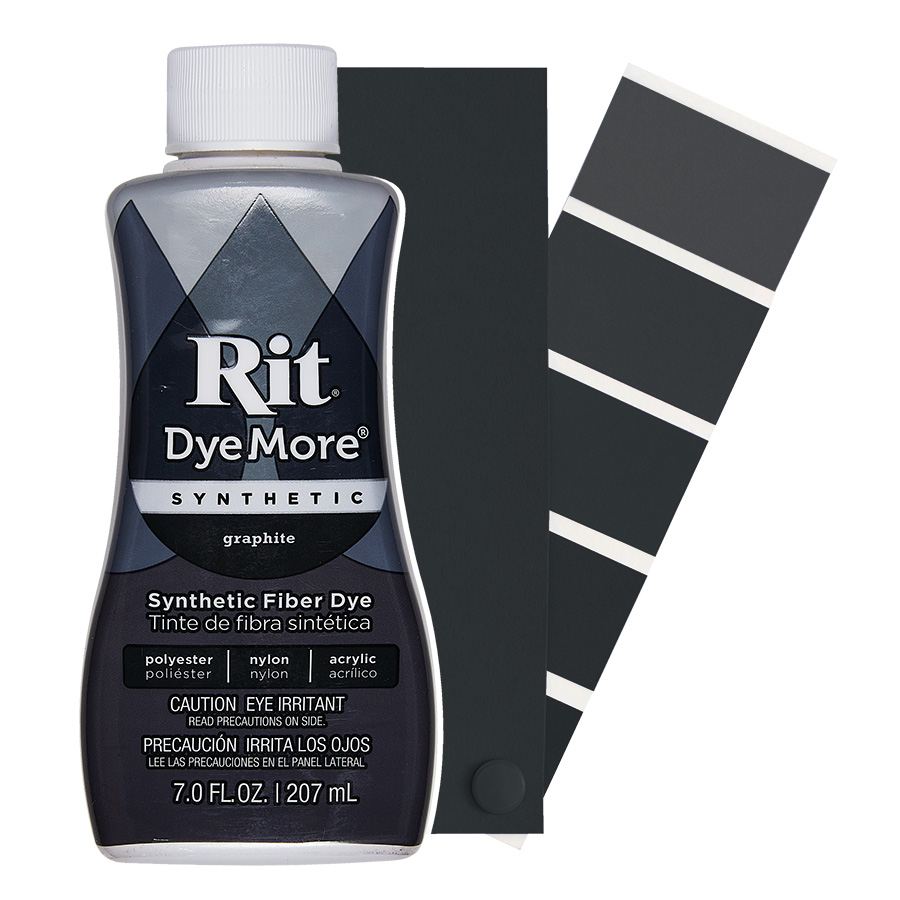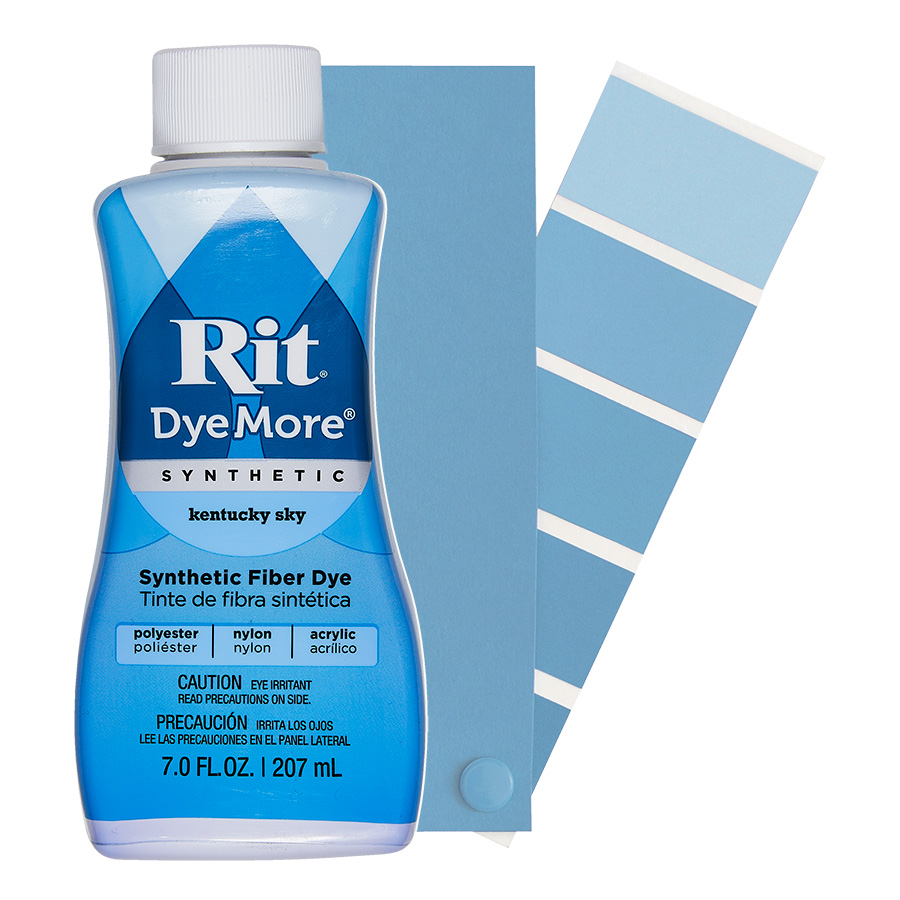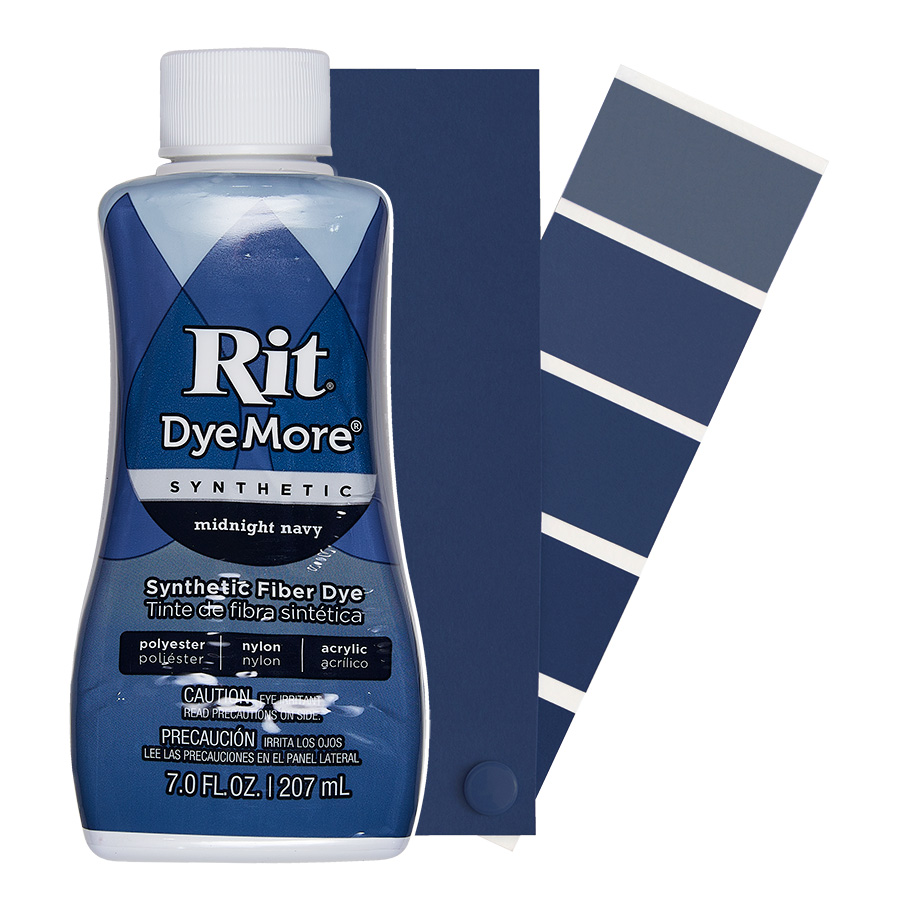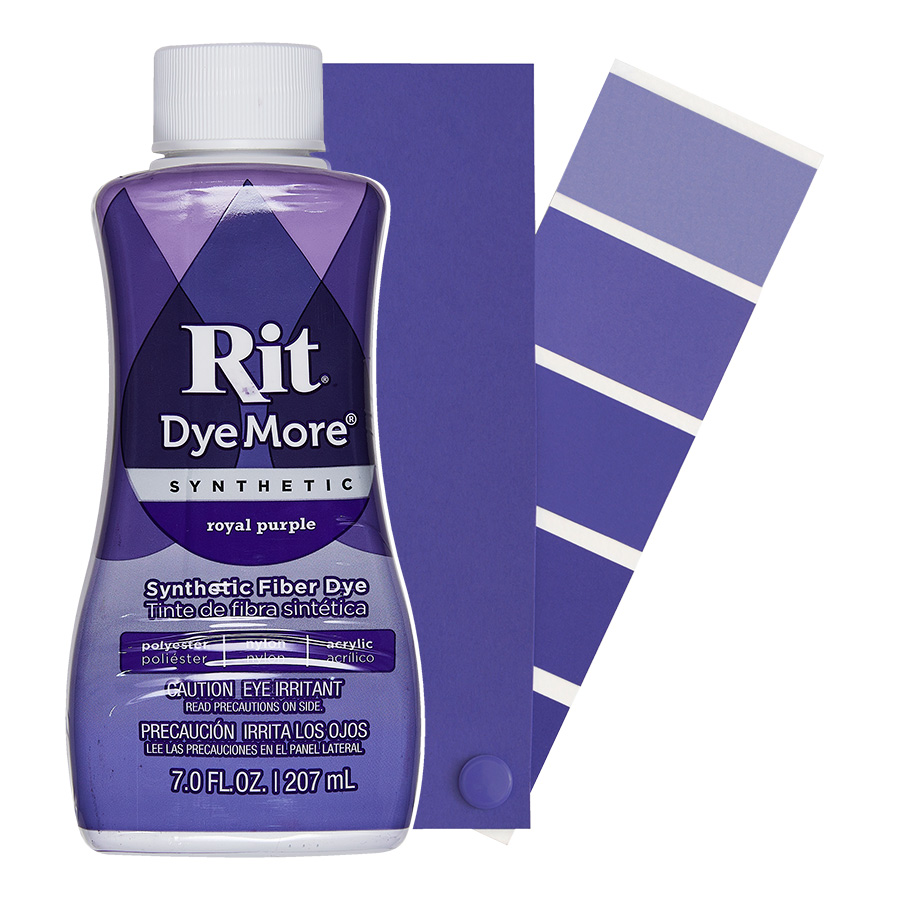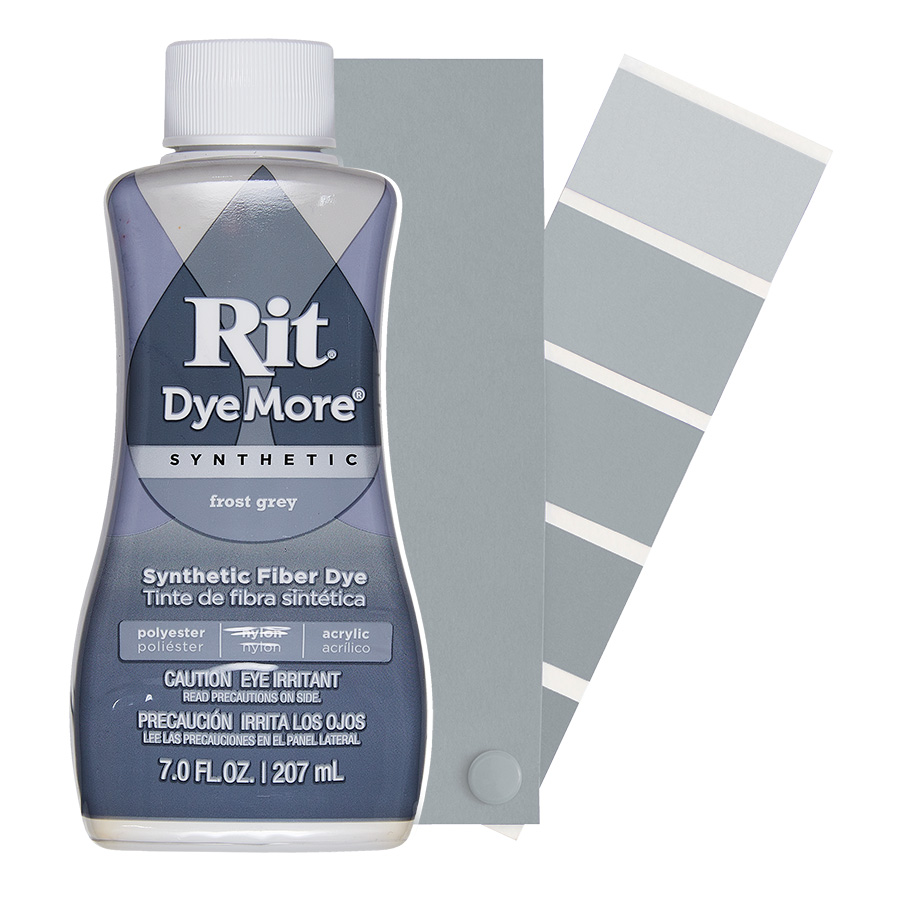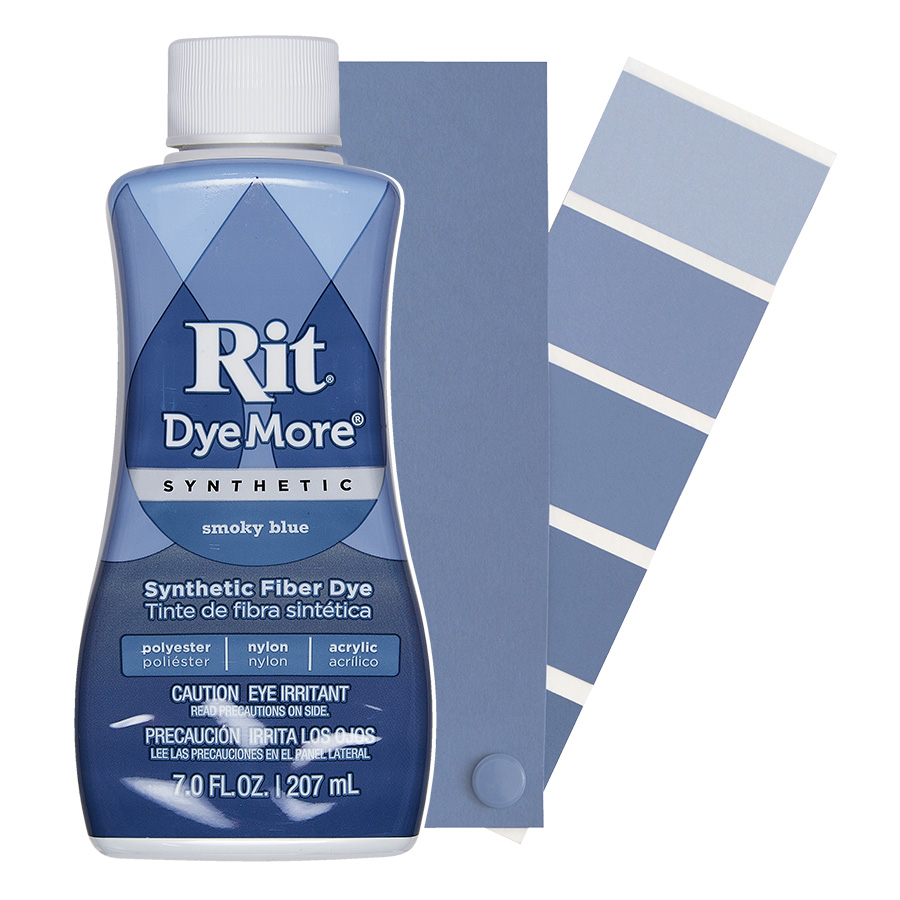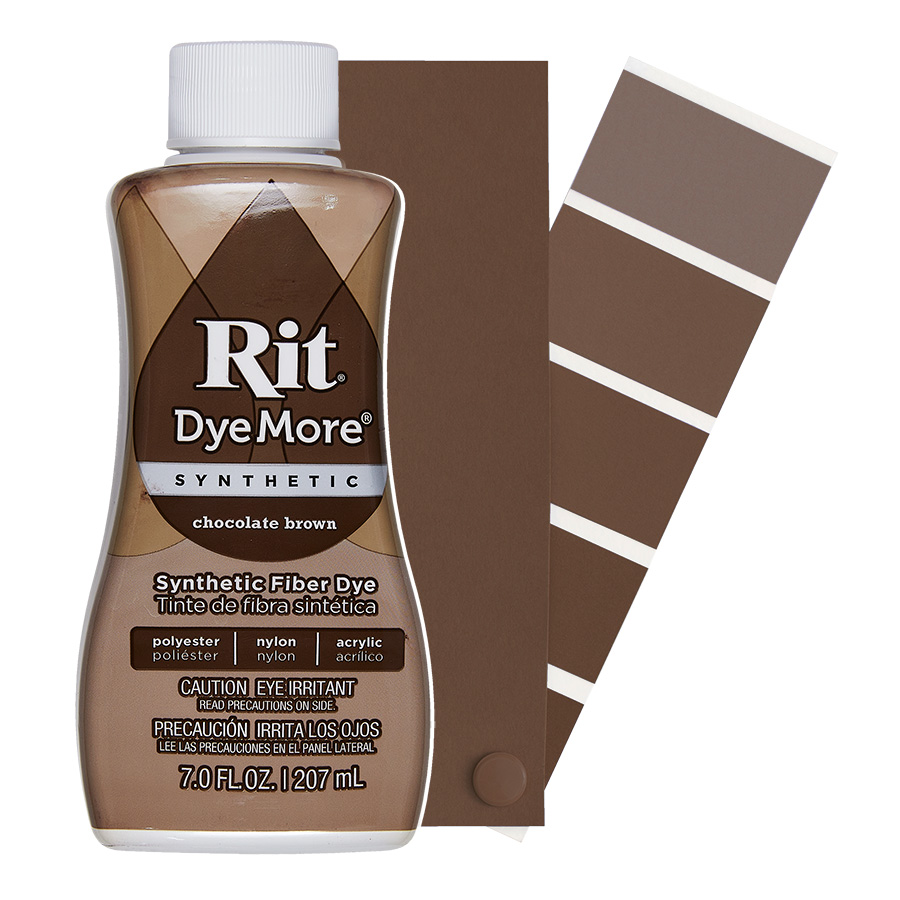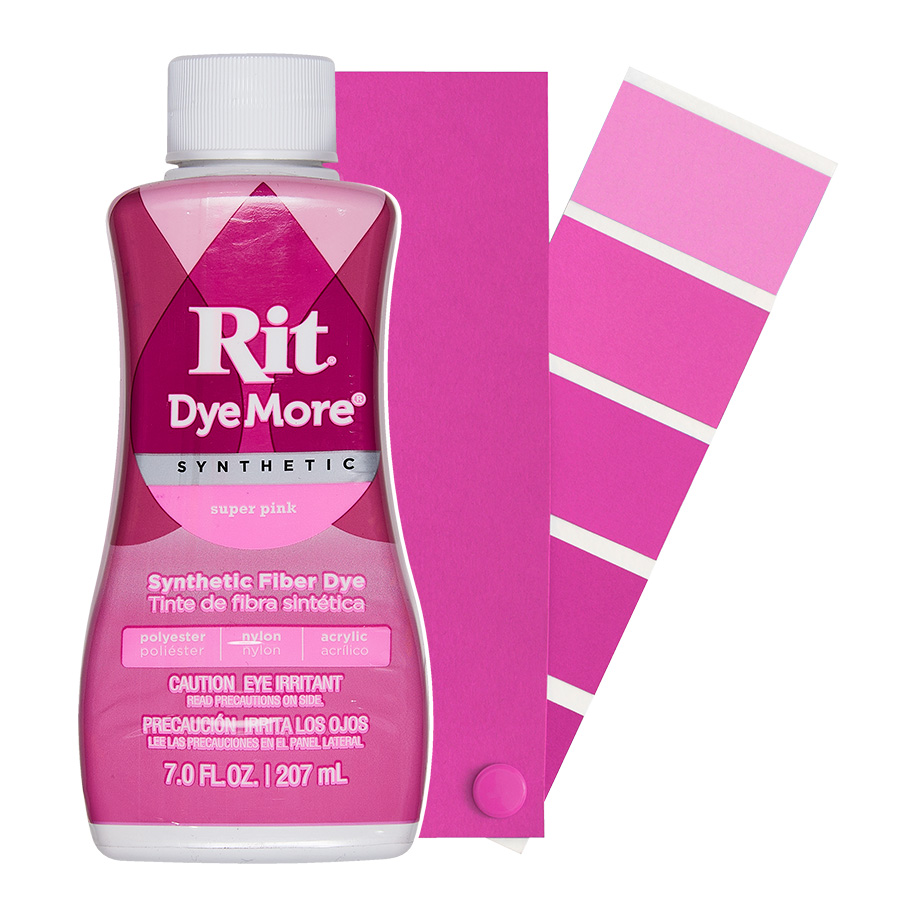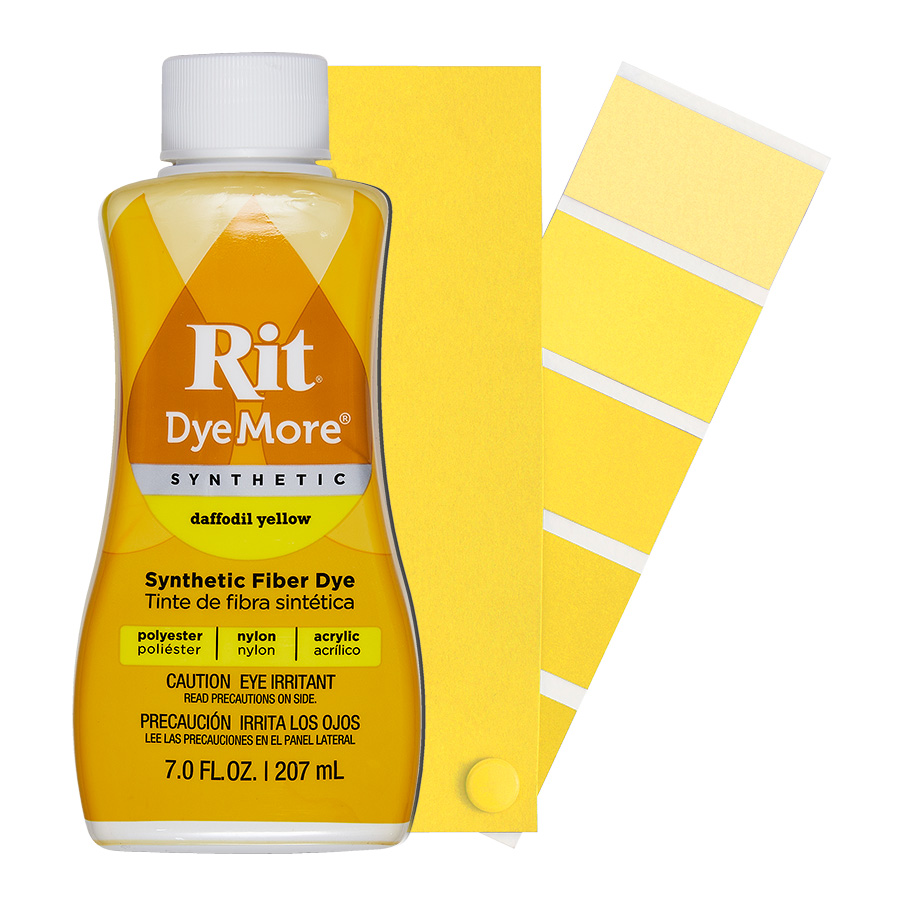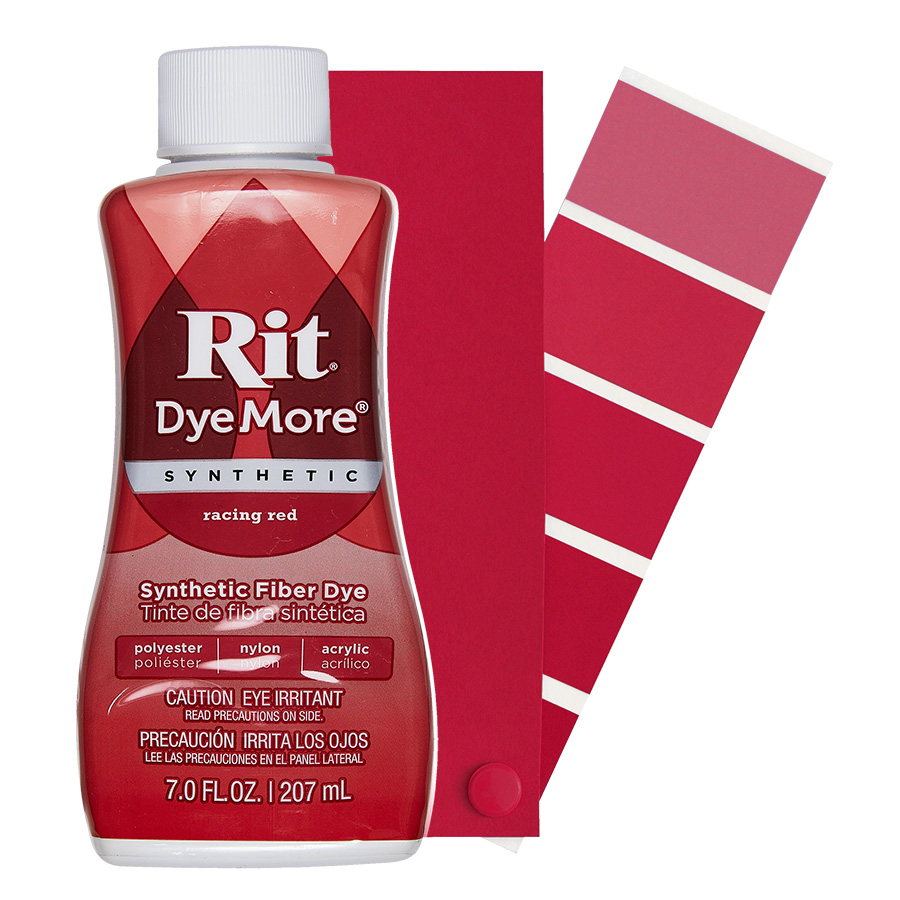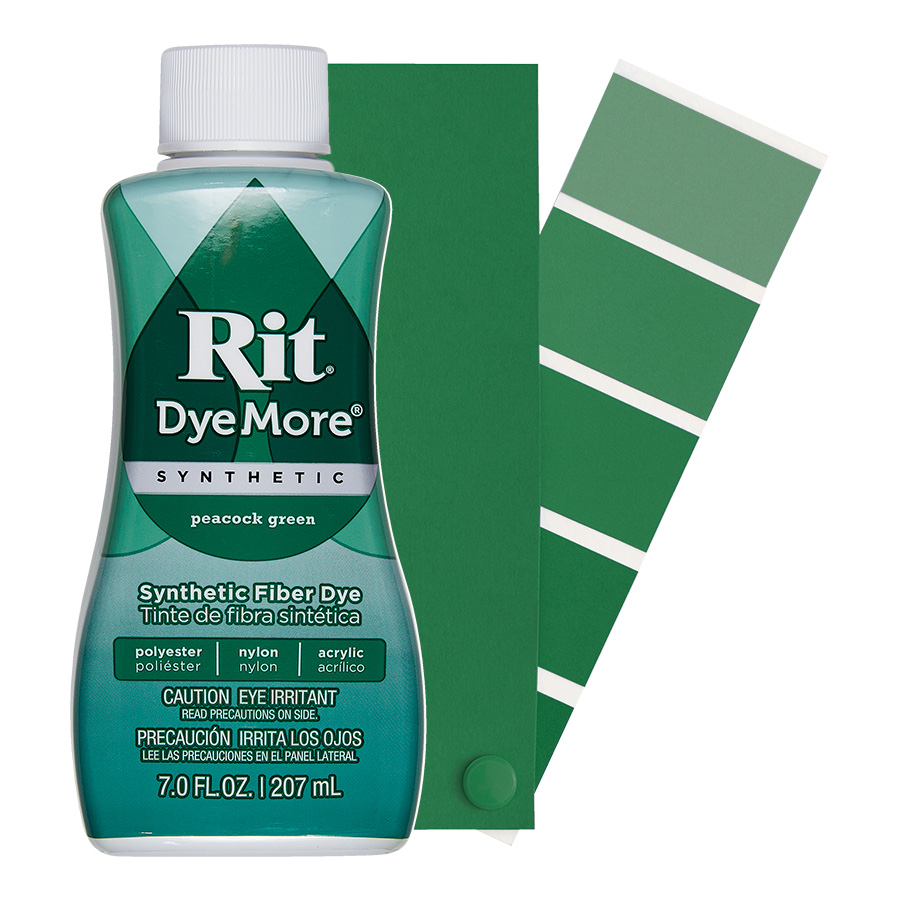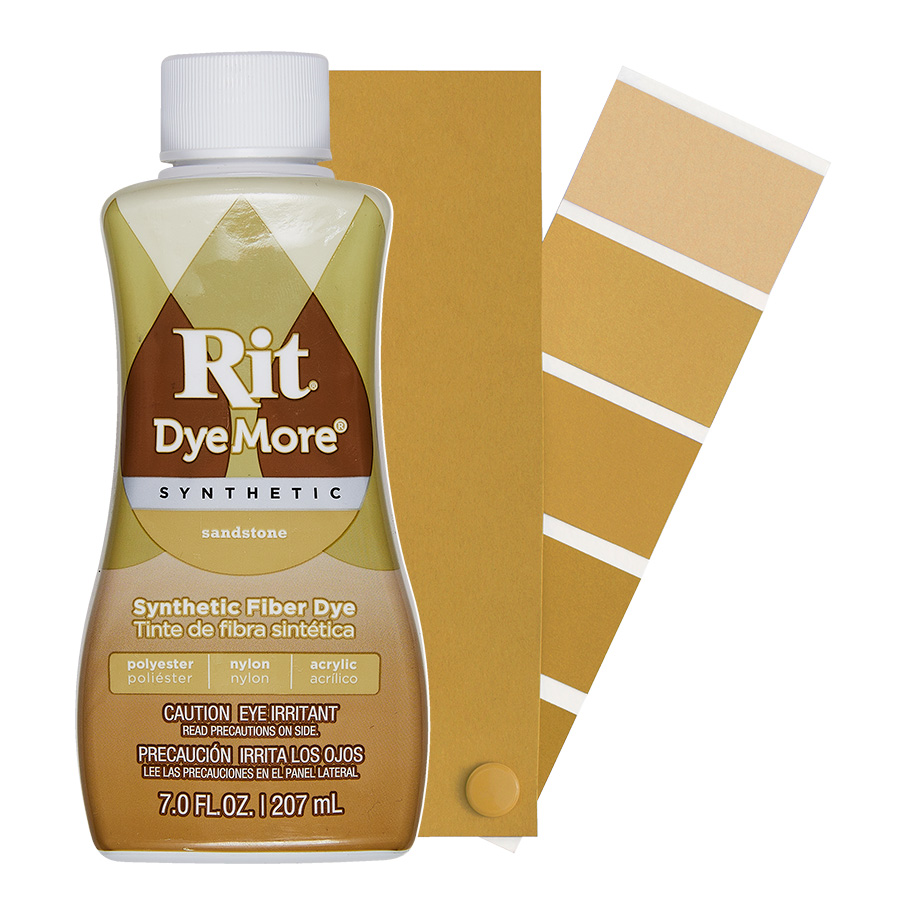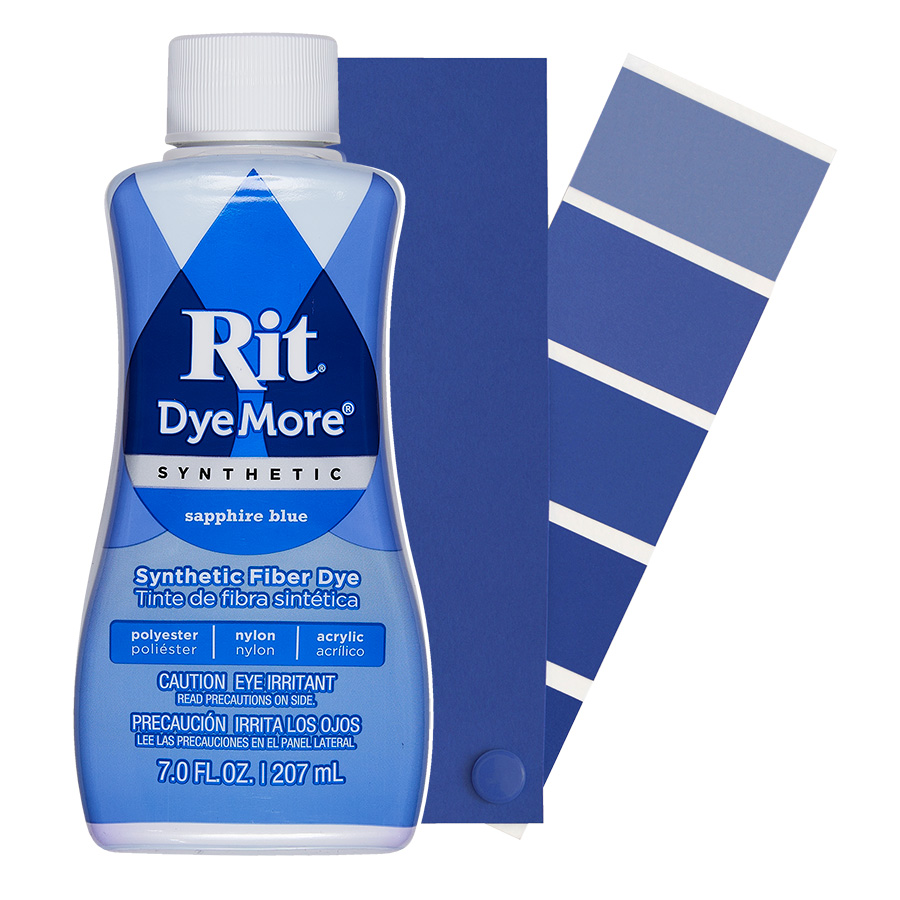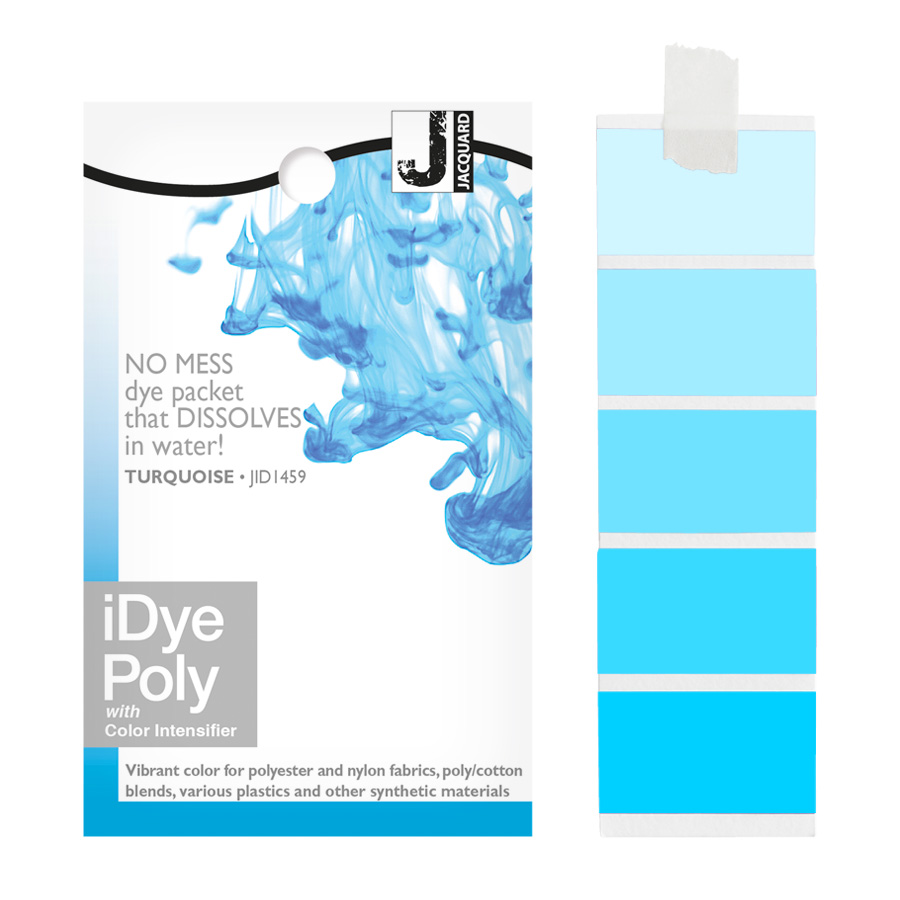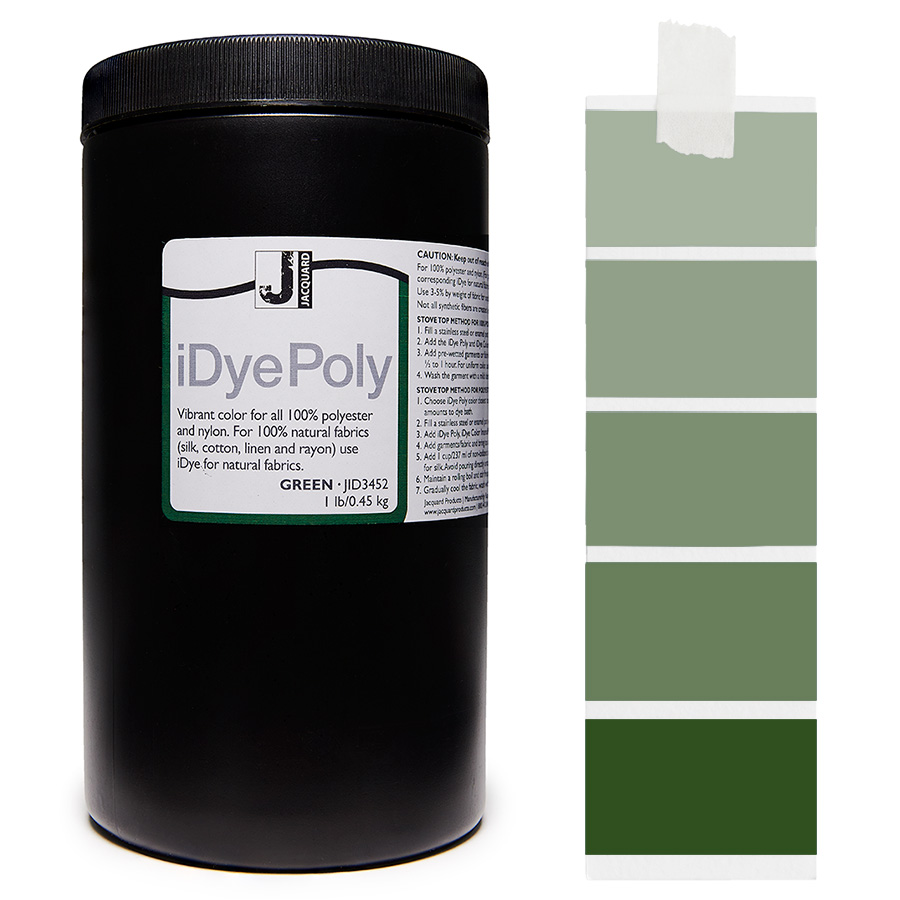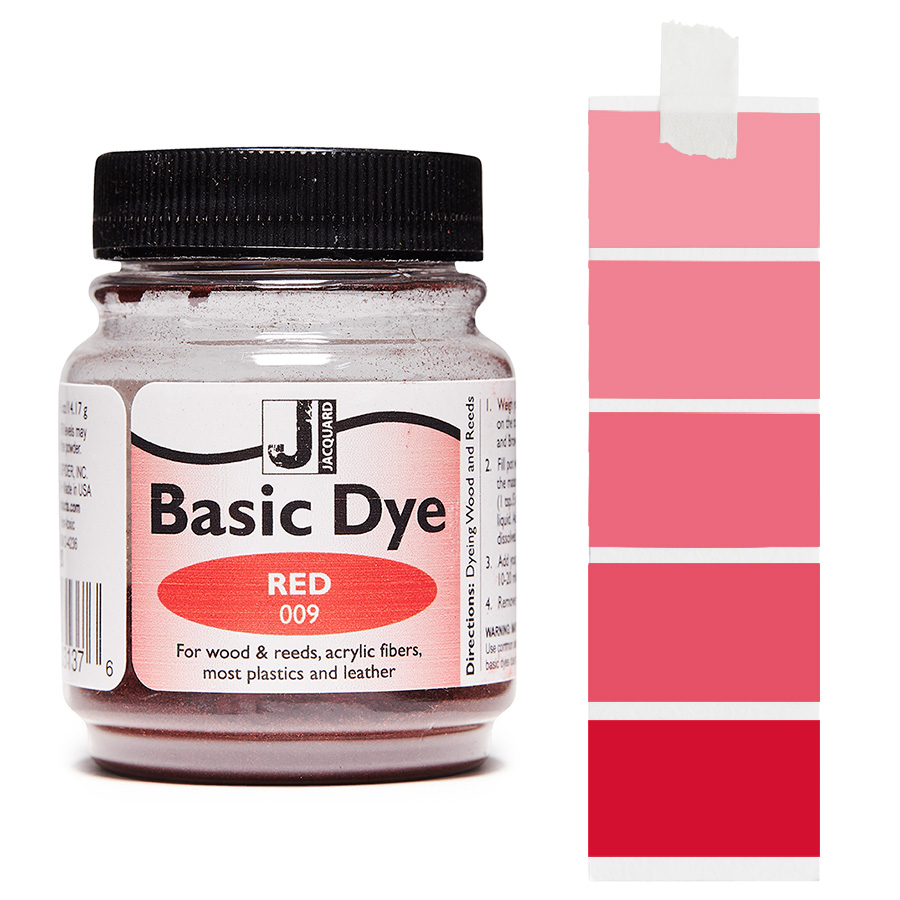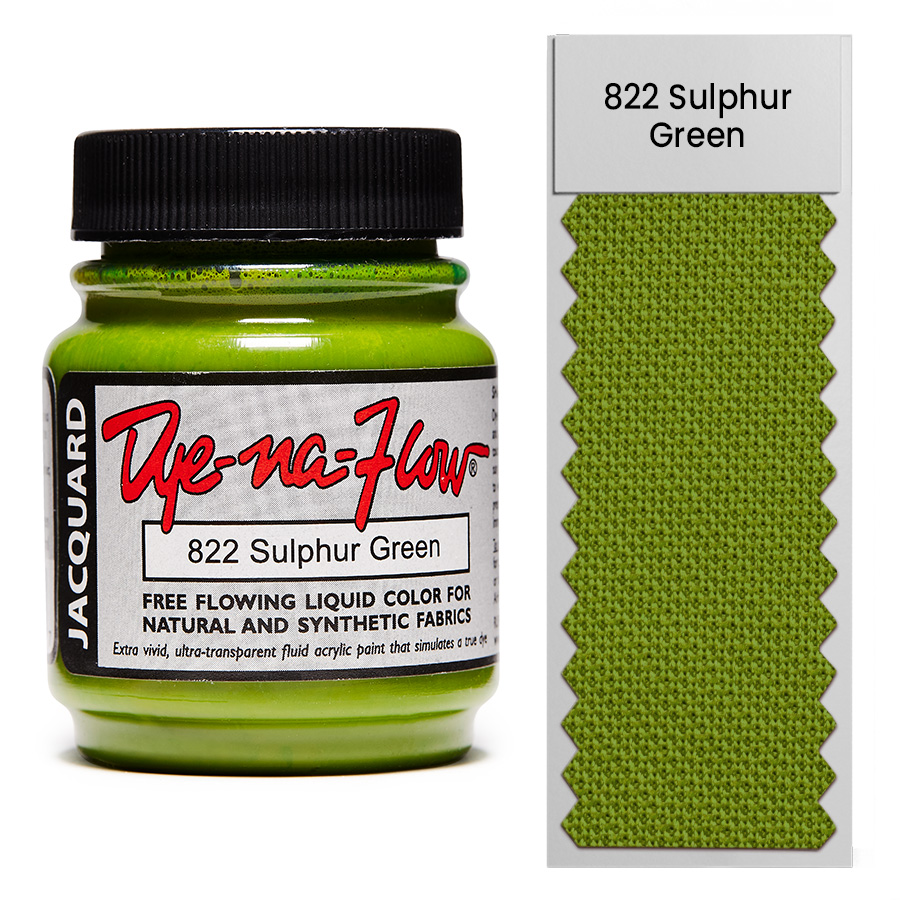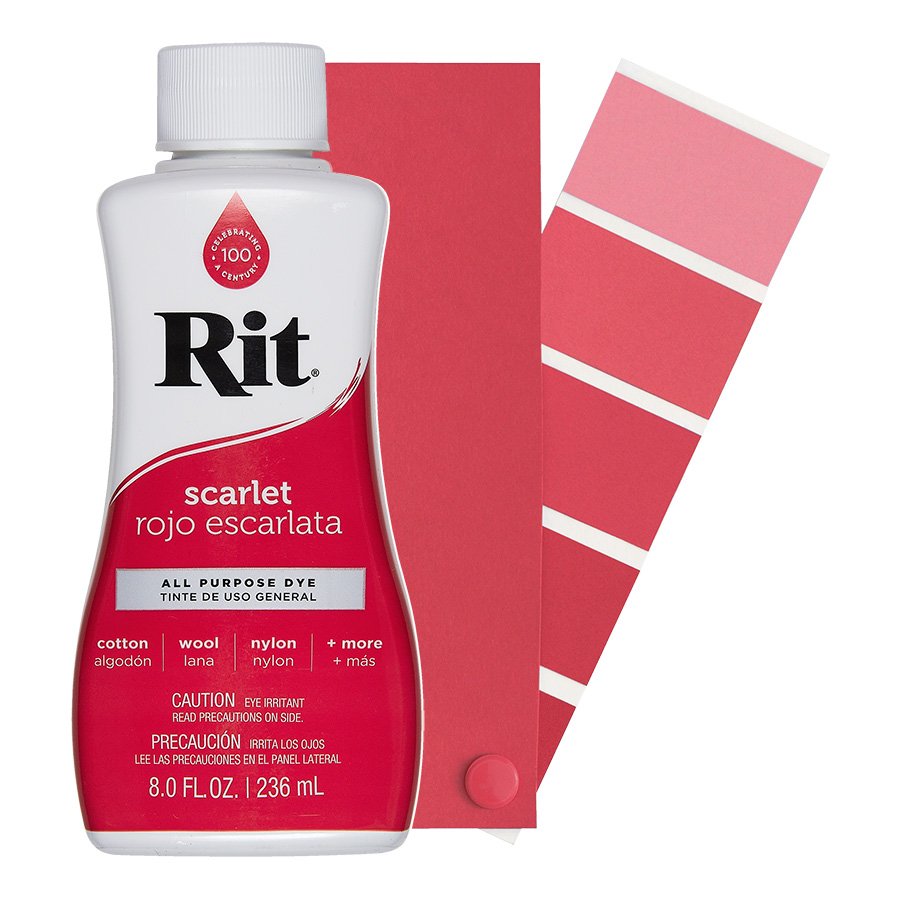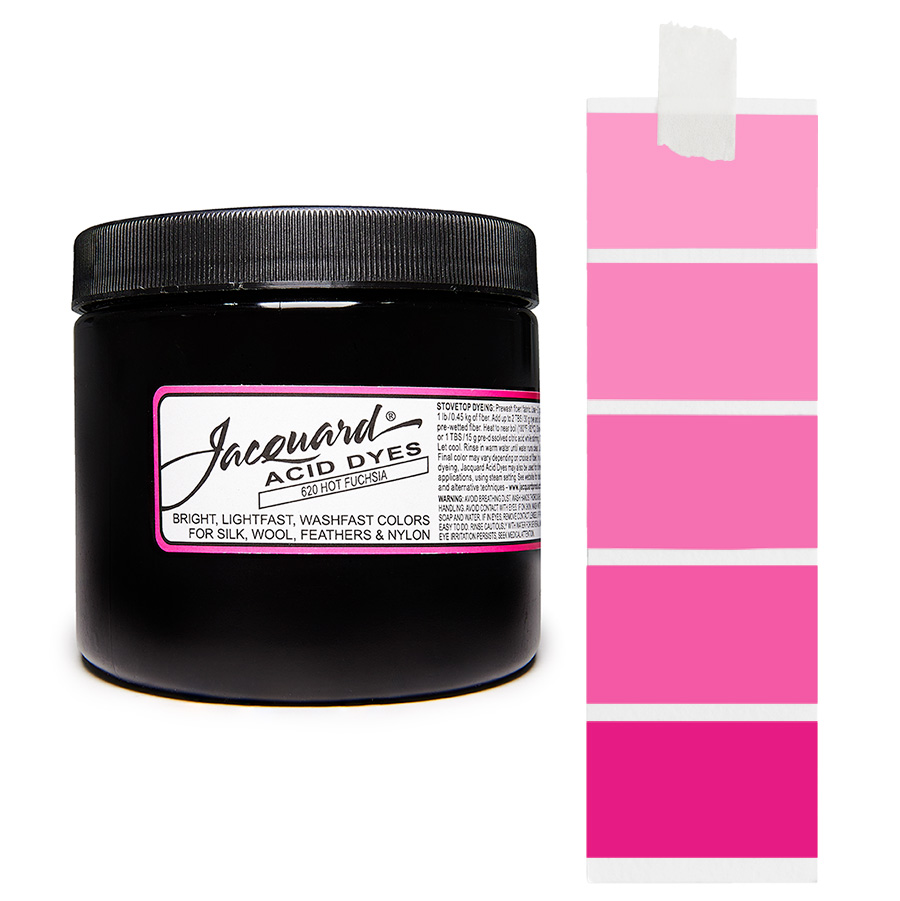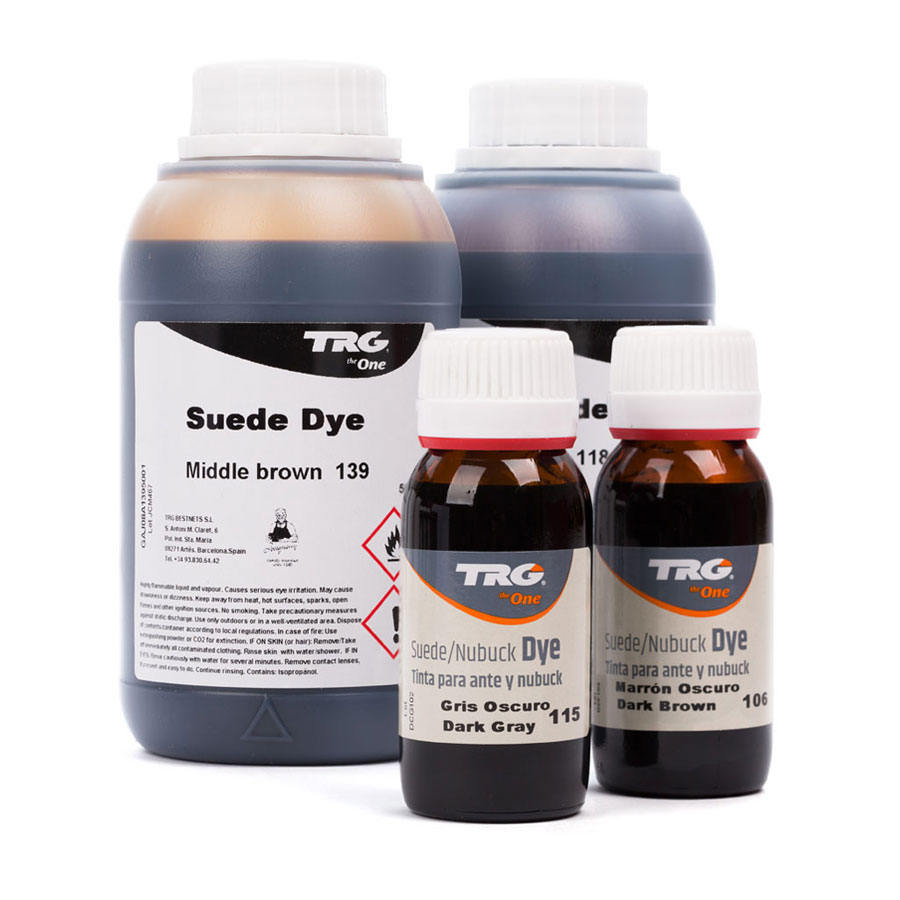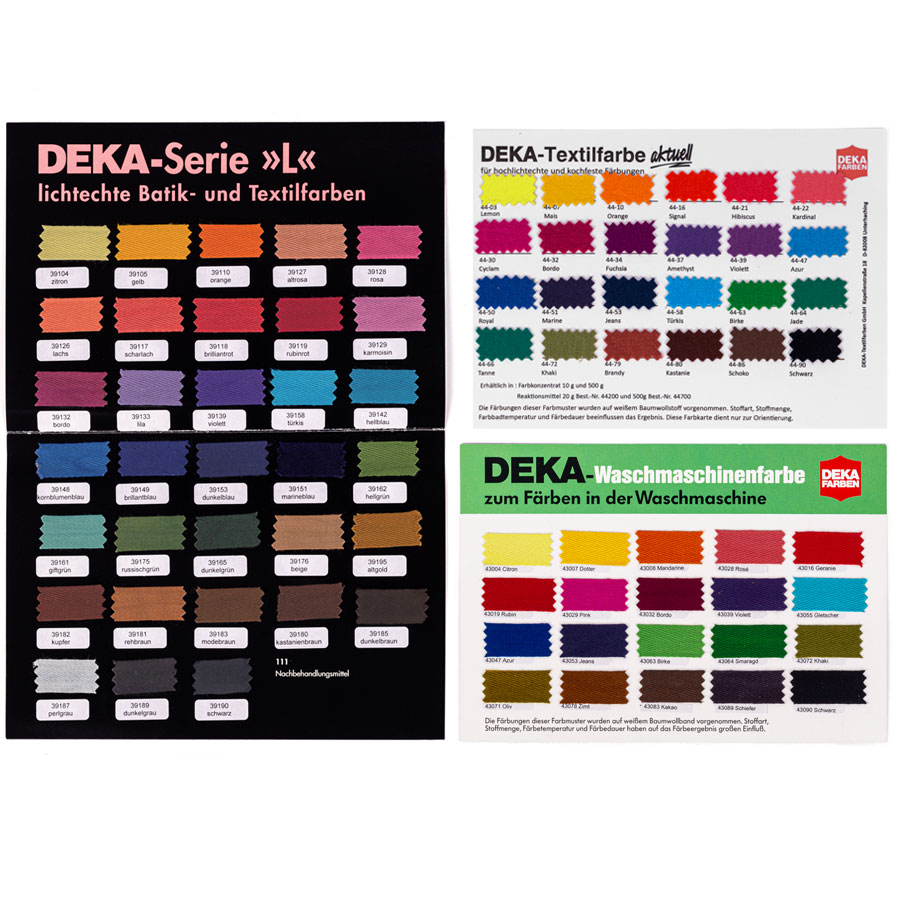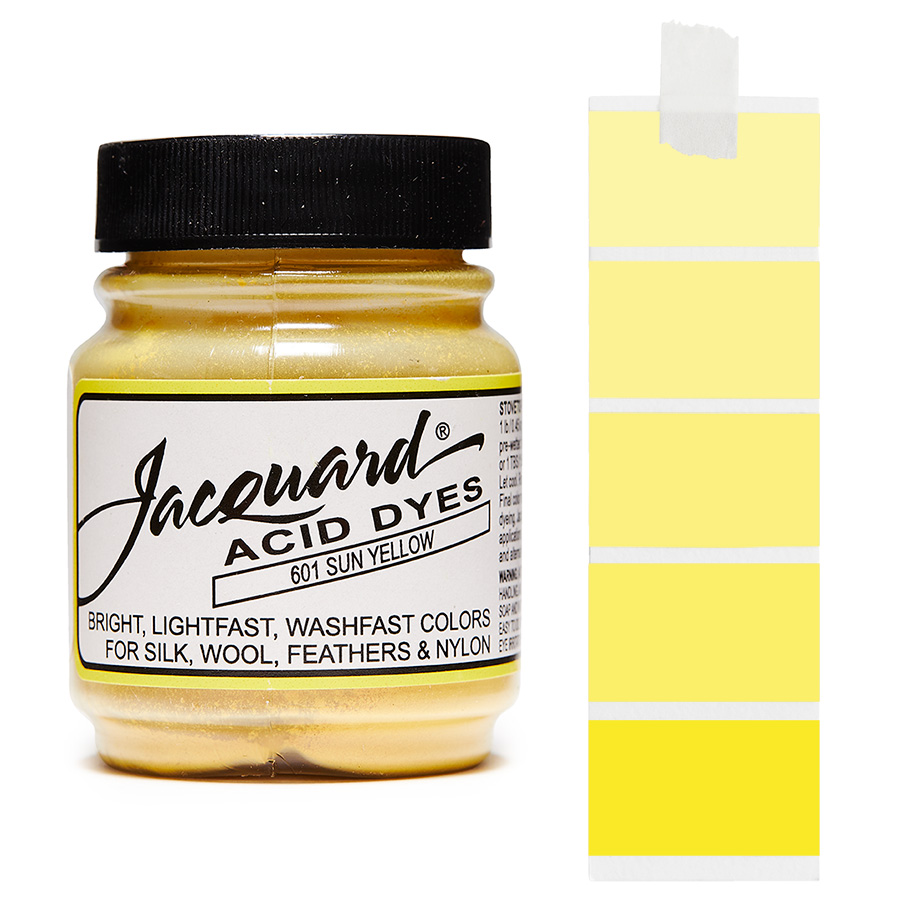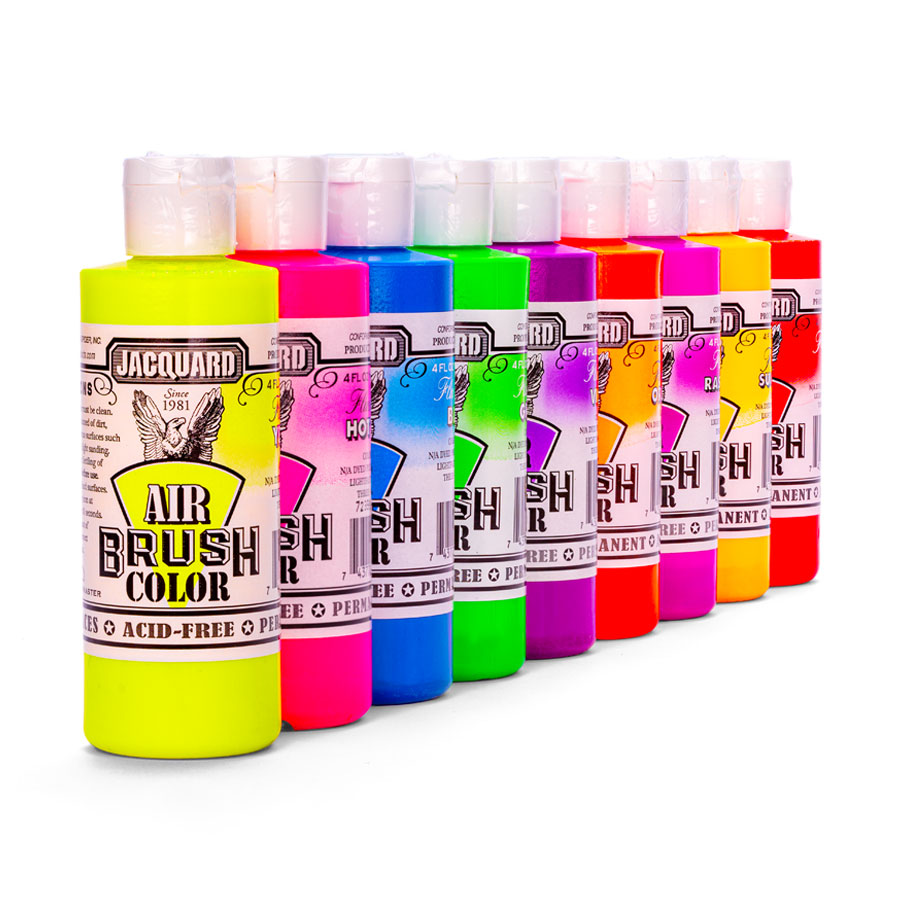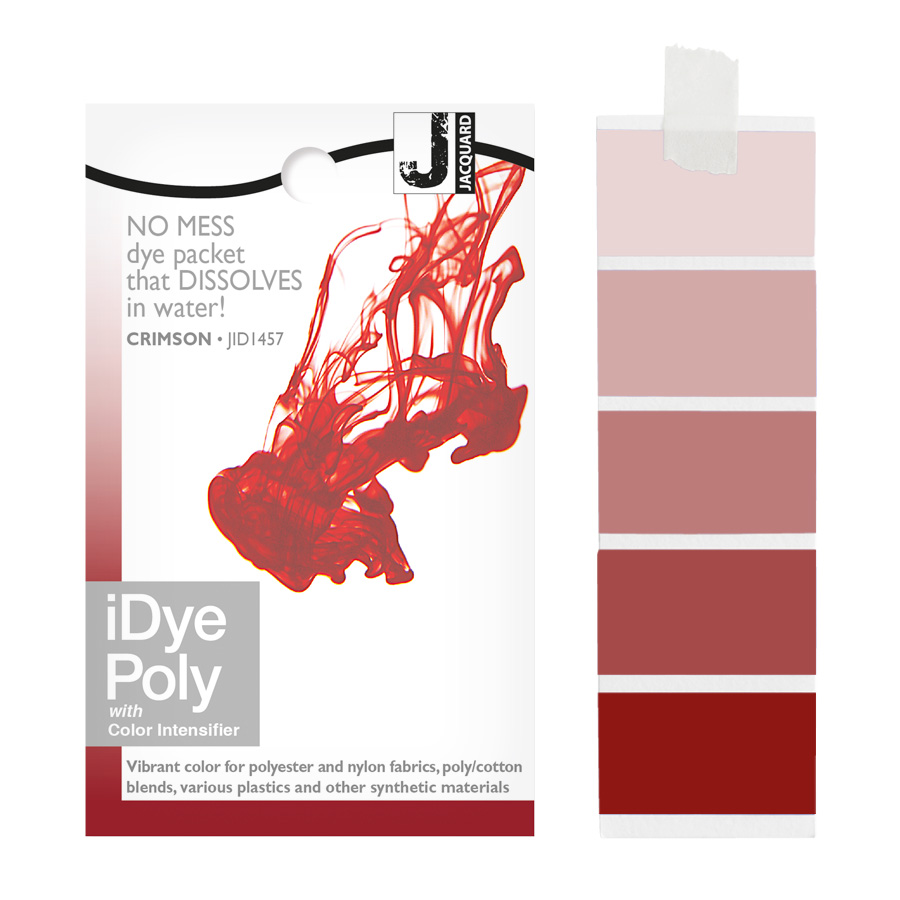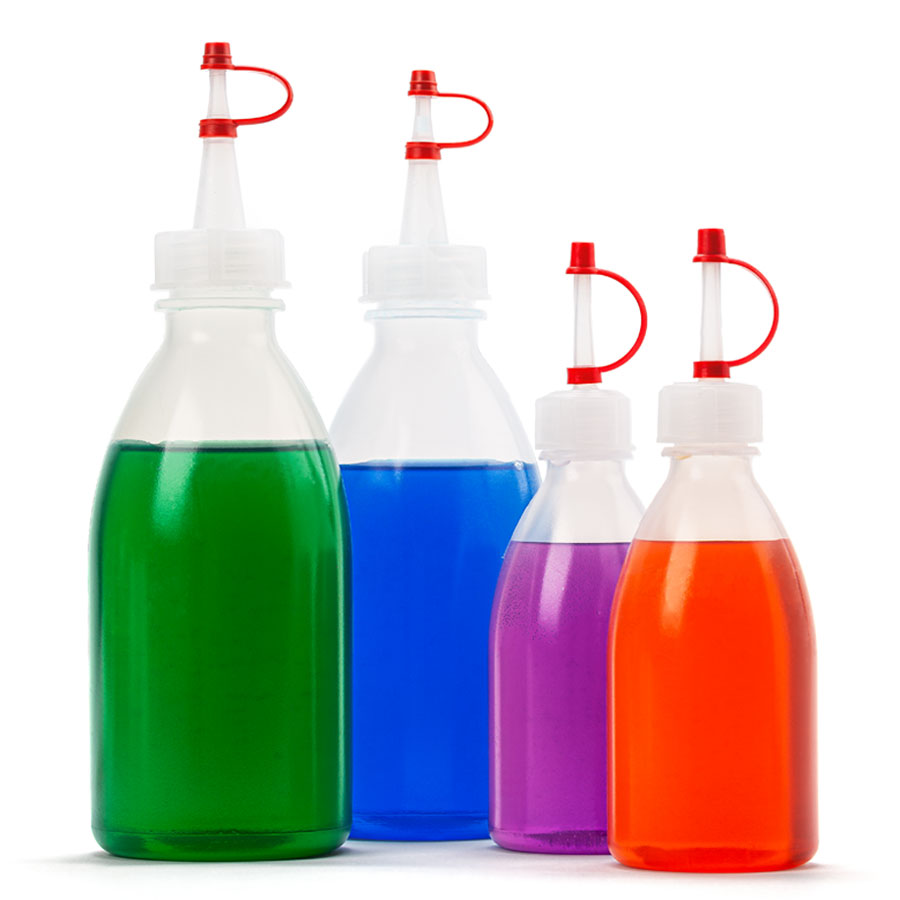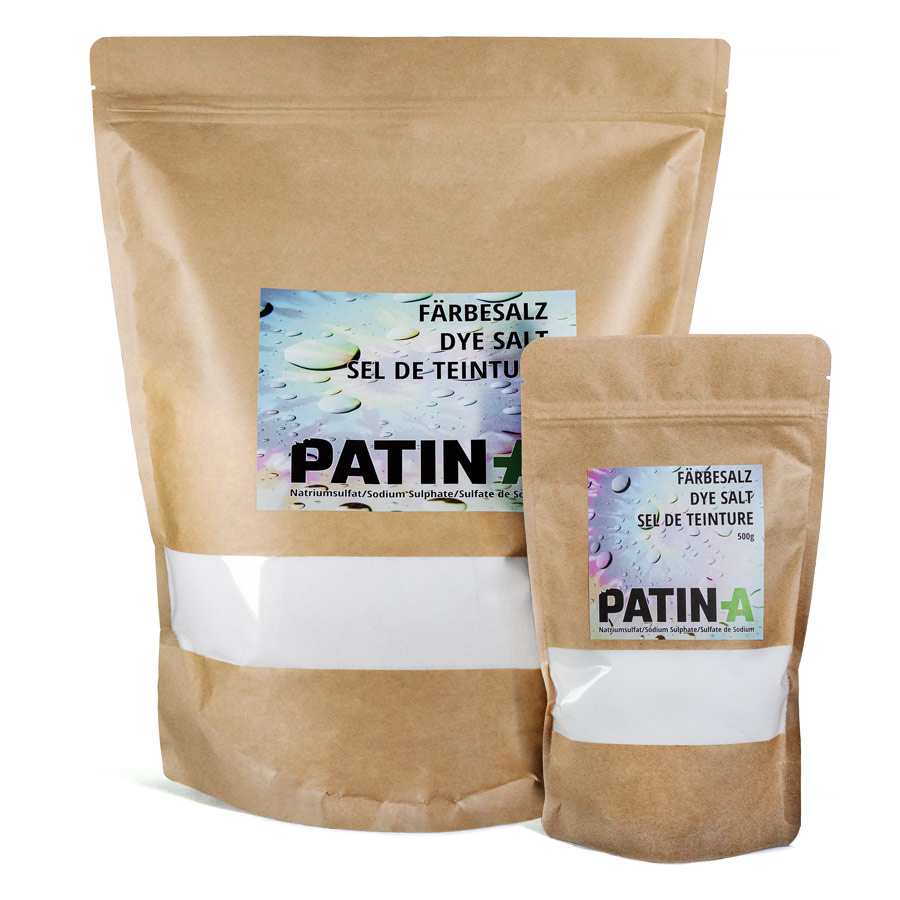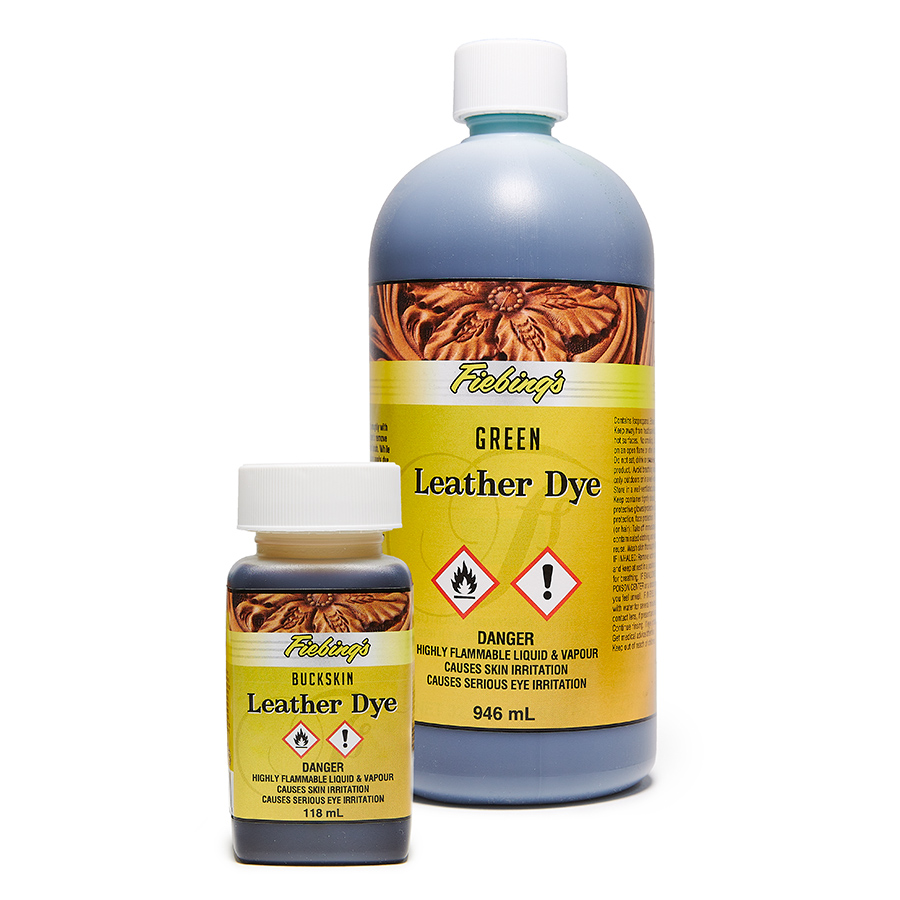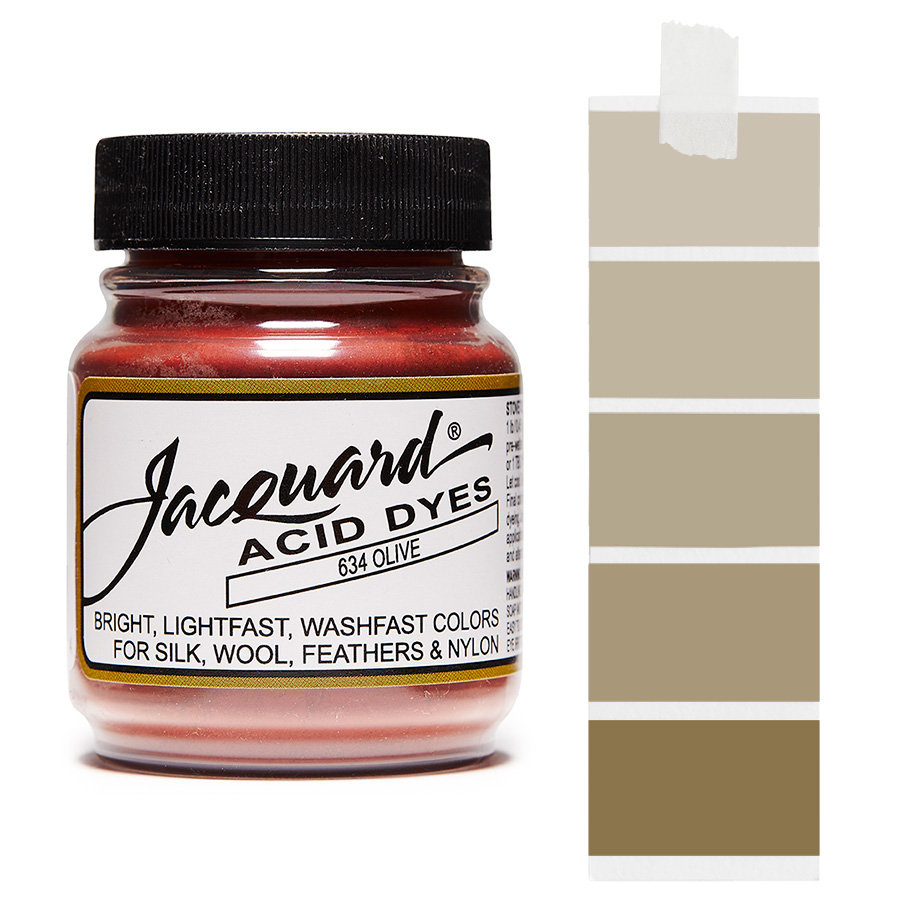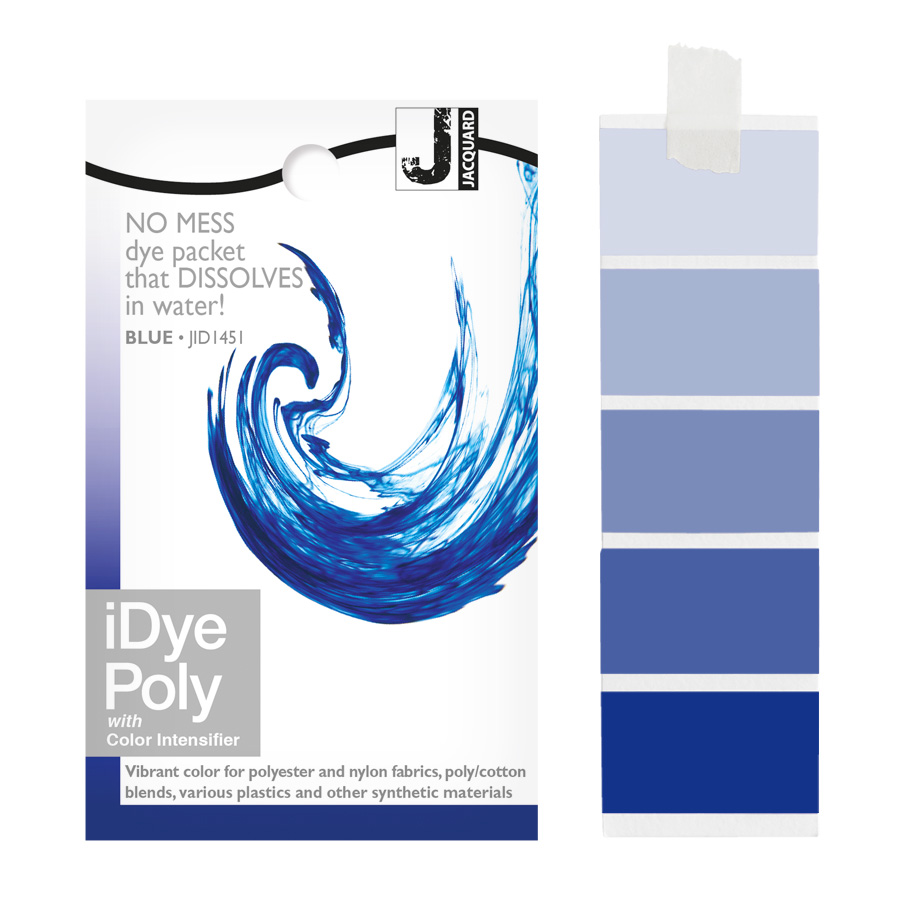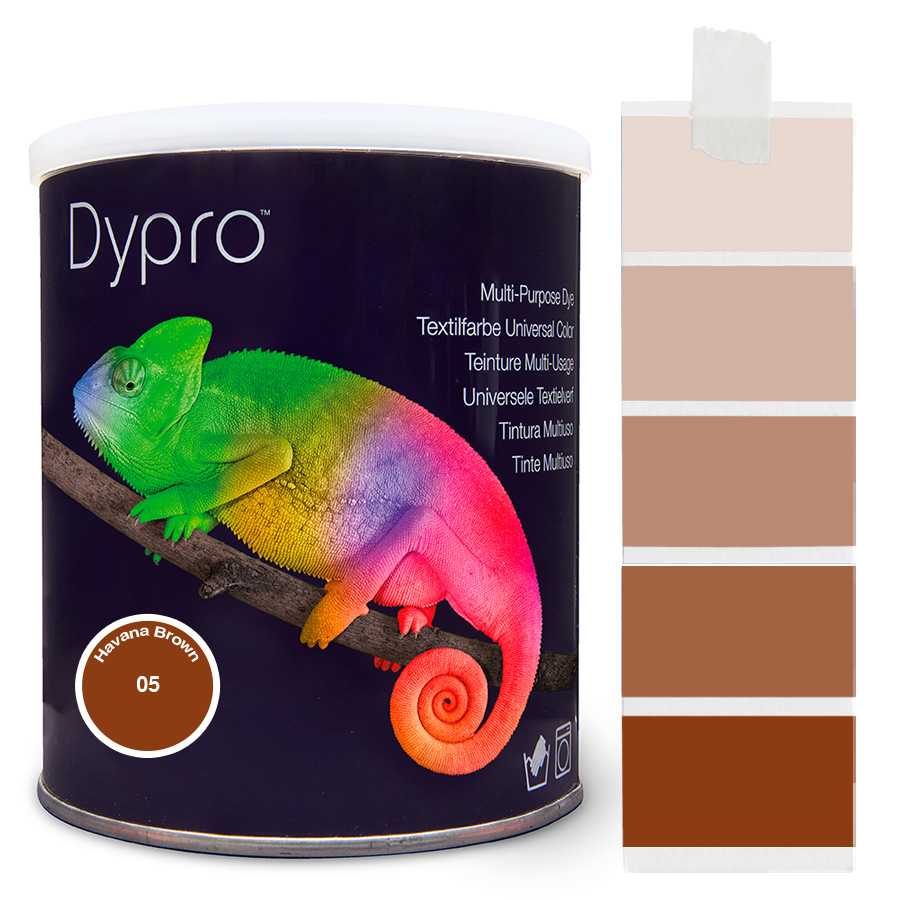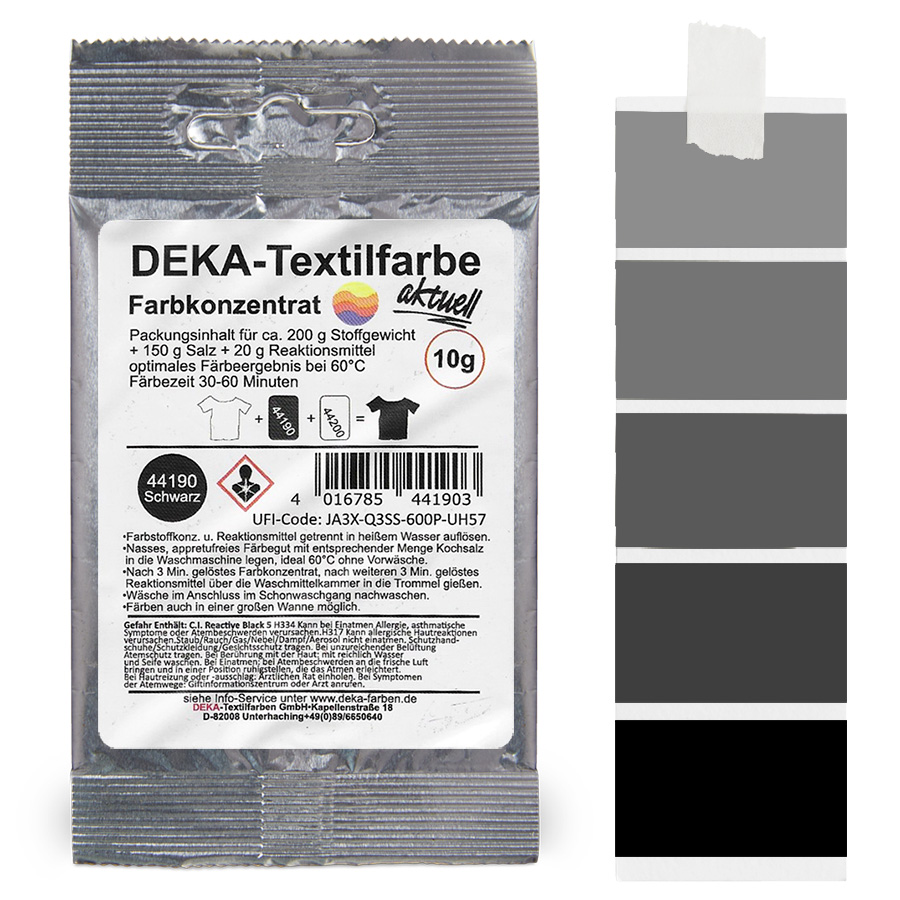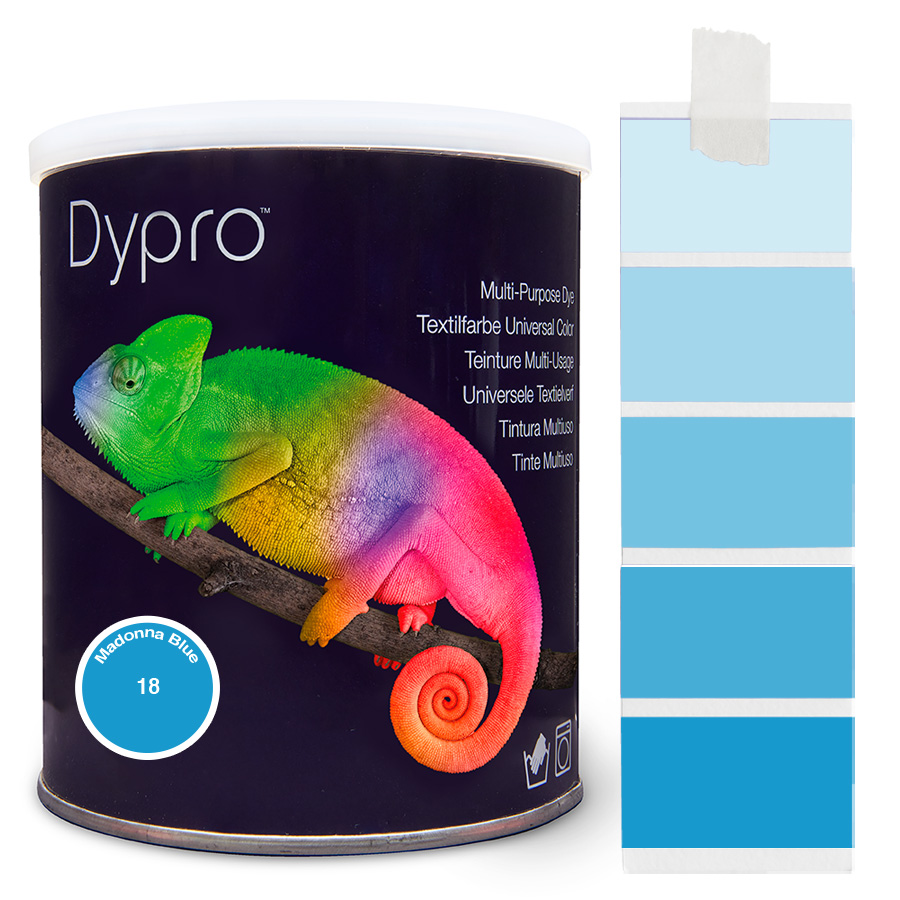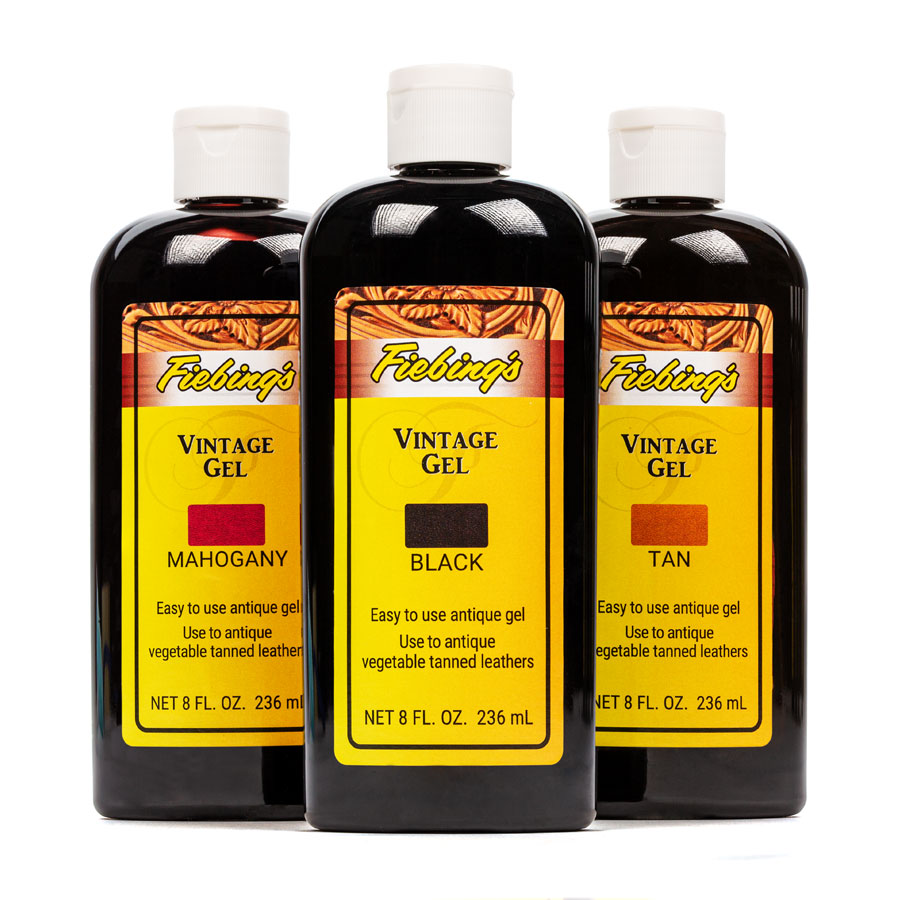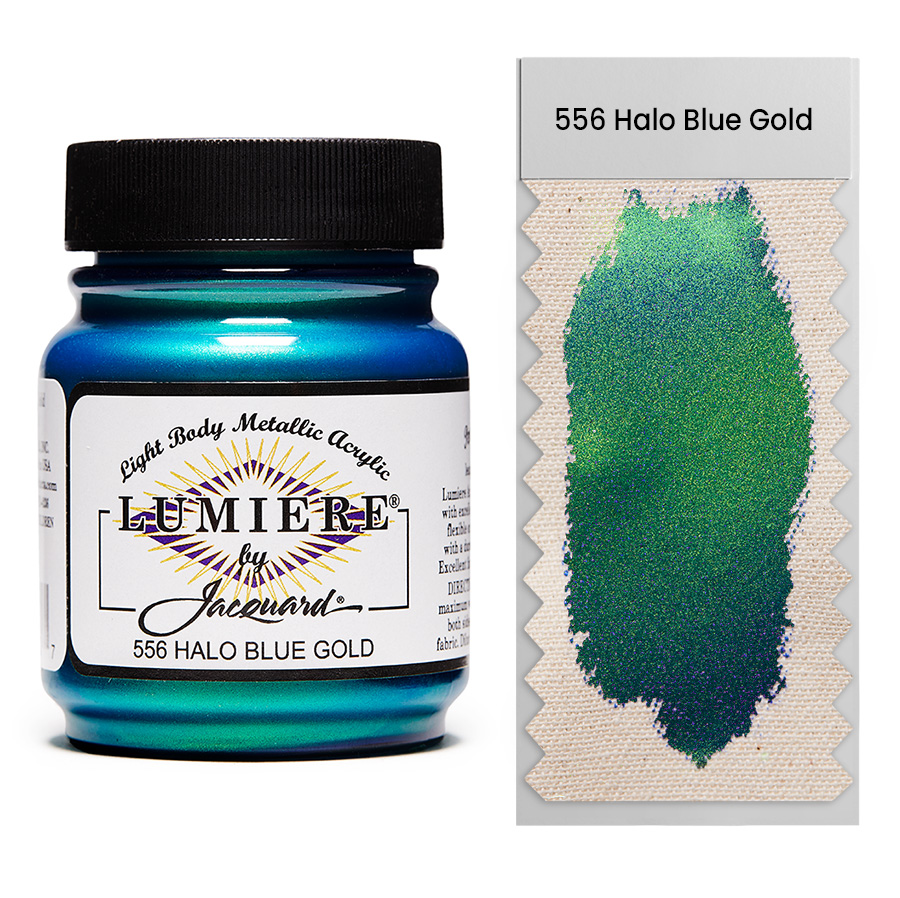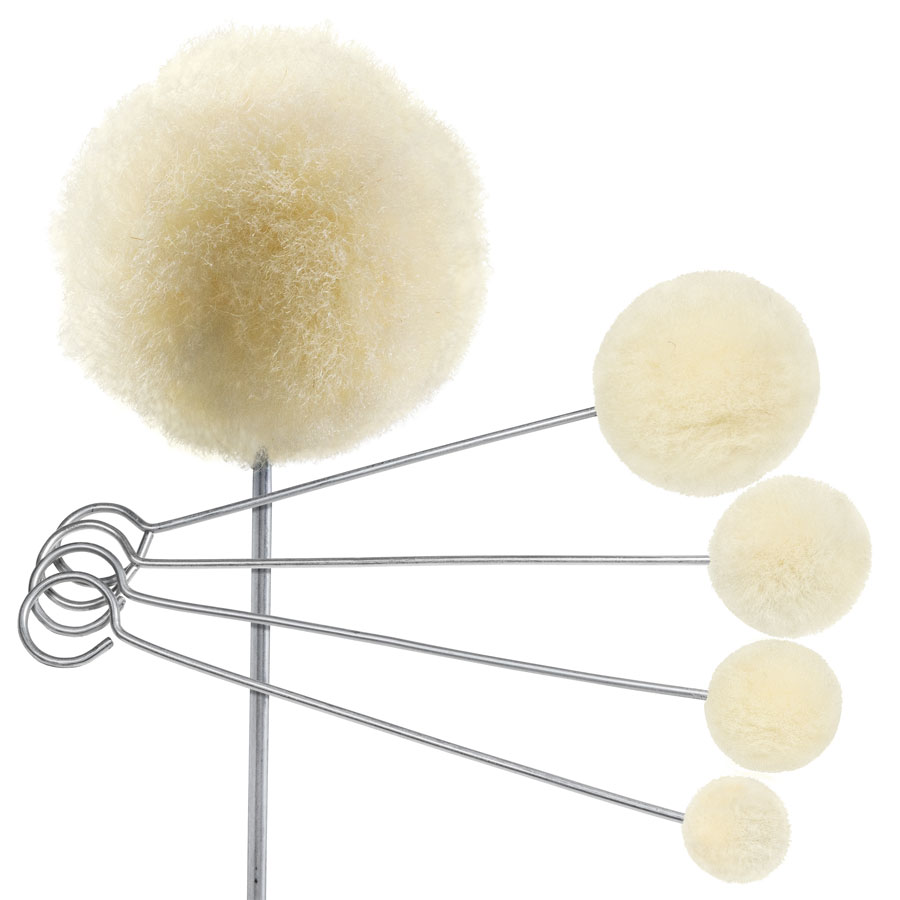Rit DyeMore - Polyester & Synthetics Textile Dye
Available, delivery time: 1-3 days
Easy-peasy dyeing of polyester & synthetics with Rit DyeMore
As there are so many different synthetic fibres, Rit® has developed DyeMore, a liquid dye that colours polyester, acrylic, acetate and synthetic blended fabrics.With DyeMore, you don't have to dissolve colour pigments or mix different components to get intense dye results as the dye comes liquid in a bottle.
DyeMore is non-toxic and perfectly suited for use at home.
DyeMore is a hot water textile dye for dyeing in a pot. The dye temperature is 93ºC.
Washing machine dyeing is not recommended as the required temperature of 93º C is not reached. The colours are paler.
If you would like to dye polyamide (e.g. nylon, spandex etc.) or blended materials with less than 35% of synthetic fibres, take Rit All-Purpose Dye.

A hot dye at 93°C at least? The label says: Wash polyester or synthetic fabrics only up to 30°C!
To dye polyester fabrics or other synthetic fibres you need very high temperatures.
Forget the manufacturer's instructions on the washing labels in the garment! Cotton and linen tolerate a hot wash without any problems - just like polyester or polyamide (nylon).
Have a go - dyeing in a pot is very easy.
High spin speeds and tumble drying are more problematic. This causes garments to shrink. Not a hot wash.
How much fabric can I dye with one bottle of Rit DyeMore?
To find out how much dye you need, weigh the piece to be dyed on a kitchen scale or estimate the weight.
Here is a general guideline: one bottle of Rit DyeMore is enough for dyeing up to 1 kg of dry fabric.
If you want to dye 100% polyester or achieve a very strong colour tone, double the amount of dye.
The fibre content and the weight will influence the dye result. If you are not sure whether your fabric will take the dye or reach the desired colour tone, we recommend that you dye a sample first (professionals always make tests first before dyeing a garment).
I want to dye polyester black, but the colour is missing from the selection!
We asked ourselves why there is no black shade in the Rit DyeMore colour chart.
Rit's answer was surprising: you cannot achieve a 100% black in polyester dyeing. However the shade "Graphite" comes very close to the desired result. Rit Dye does not want to give customers false hopes and for that reason has named its darkest dye "Graphite".
If you want to dye black, go ahead and use "Graphite" - it's a very pure dark anthracite and is guaranteed to please!
Polyester dyeing in the washing machine?
Due to the complexity of synthetic fibre dyeing, you must use the stove top method to maintain an almost boiling temperature for the duration of the dye process (93°C or higher).
Consequently, you can neither dye anything that will not fit in a pot on the stove nor use your washing machine as it is not able to reach the water temperature that Rit DyeMore needs to penetrate the fabric.
Rit DyeMore needs very high temperatures (at least 93º C). Almost no washing machine can manage this high temperature.
At temperatures below 93º C the garment is not dyed intensely but will get a weaker colour tone (pastel).
Dye instructions
No matter what you want to dye, jeans or curtains, the first step is the choice of the right dye for your fabric or your material. Always check the care label for the fibre content of the fabric you want to dye.
Rit DyeMore dye is suitable for synthetic fibres like polyester, acrylic, acetate and nylon. If you have a mixed garment that contains more than 35 % of synthetic fibres, you must use this dye. If you want to dye a garment with less than 35 % of synthetic fibres, use Rit All-Purpose Dye instead.
You will find detailed dye instructions at the tab: Instructions or here!
Recommendation:
• 1 teaspoon Synthrapol or washing up liquid in the dye liquor (takes the surface tension)
• Please protect yourself with rubber gloves.
Content:
• 207 ml / 7 oz. of liquid textile dye
You will find complete dye instructions here: Rit DyeMore Instructions
Selling unit: 1 piece
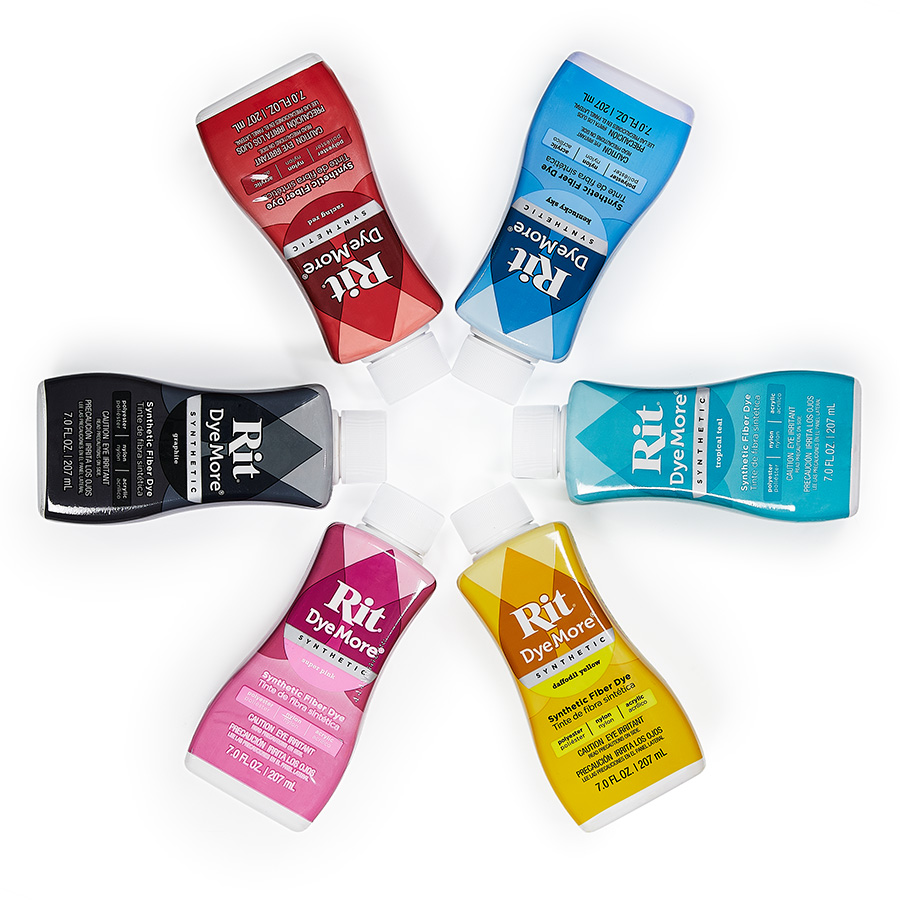
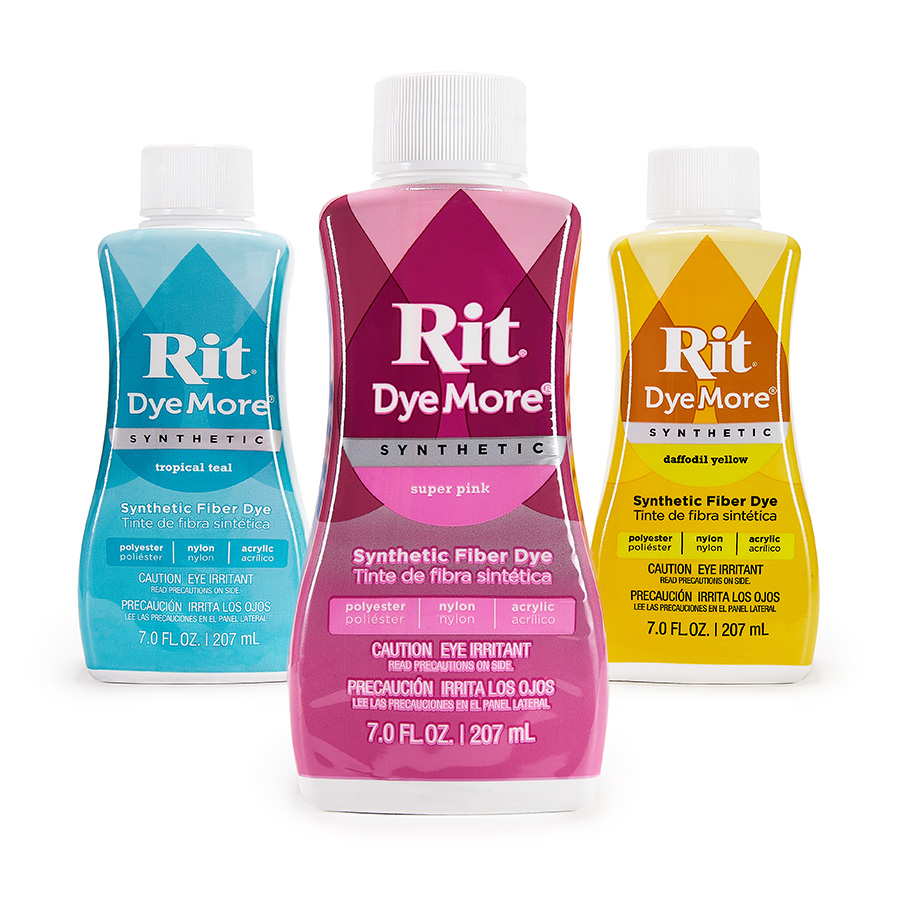
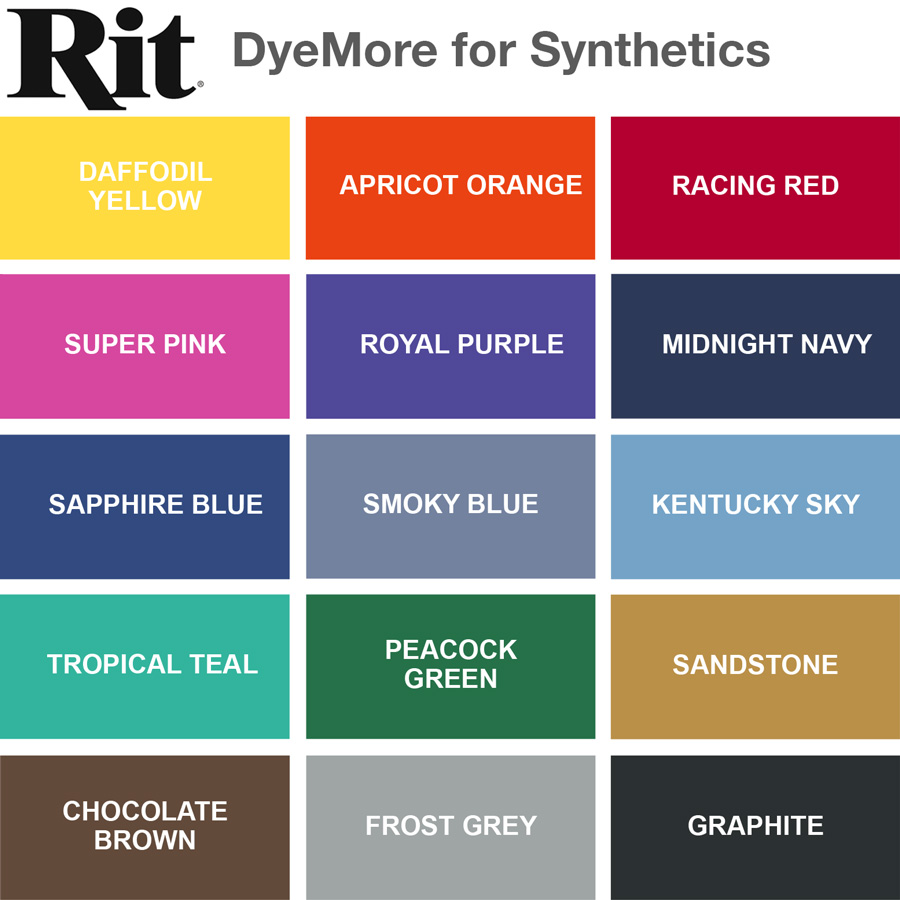
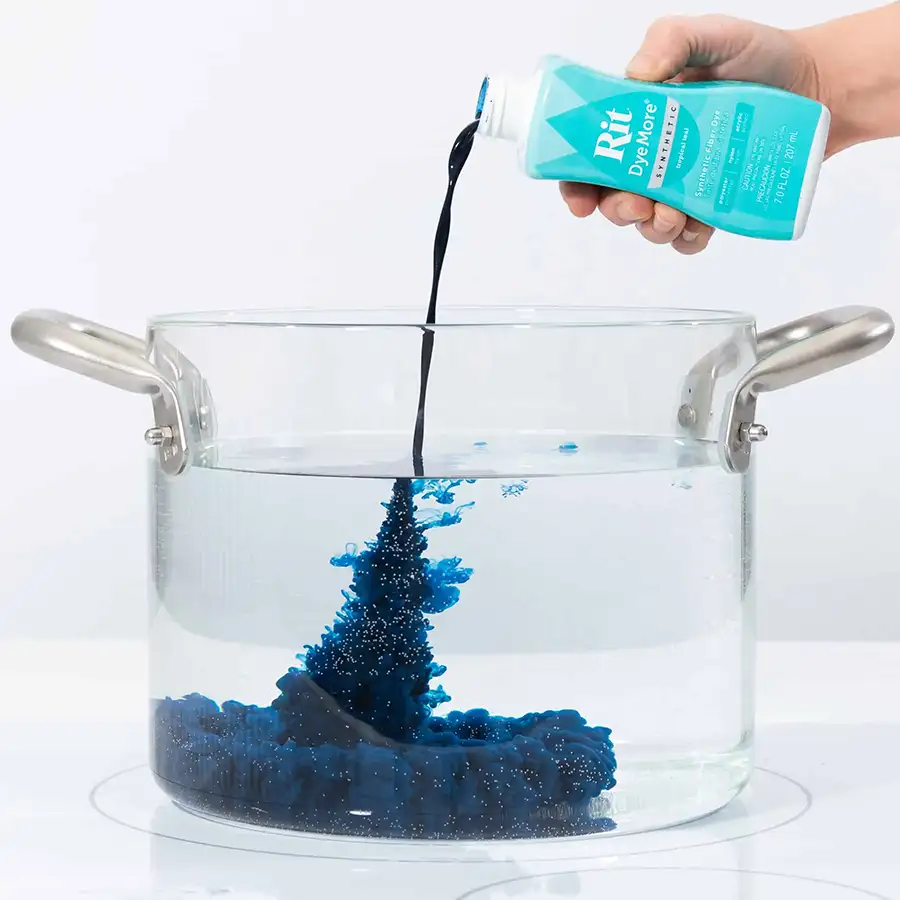
Rit DyeMore - Dye Instructions
Important information and instructions for dyeing with DyeMore:Stove top method
Due to the complexity of dyeing synthetic fibres, you have to use the stove top method to maintain an almost boiling temperature for the duration of the dye process (93°C or higher).
Consequently, you cannot dye anything that (1) cannot fit in a pot on the stove and (2) you cannot use your washing machine as it is not able to reach the temperature that Rit DyeMore needs to penetrate the fabric.
Colour
If the garment to be dyed is white or off-white, you should be able to reach a real colour. However, if your garment already has a colour, the only thing you can do is dye it a darker shade.
Unfortunately, Rit Color Remover will probably not work on your synthetic garment.
Click here to learn more about overdyeing.
Patterns and logos
If the piece to be dyed has a pattern or a logo, the dye will mix with the already existing colour/s in the fabric and create new colours. You will find more information about this in our guide for overdyeing of patterns and logos.
Bleach stains and sun damage
The sun and bleaching products damage the fabric, which makes dyeing much more difficult. Therefore, we cannot guarantee that the stains disappear through dyeing.
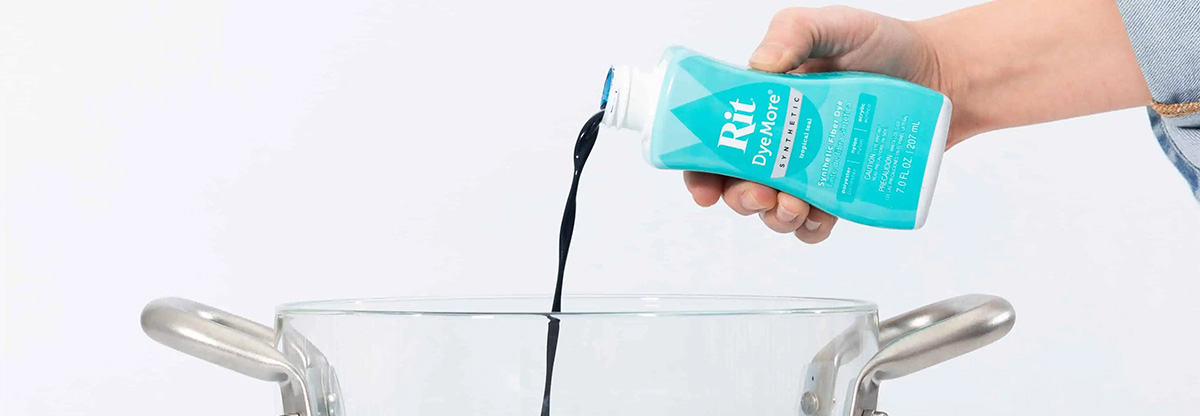
Instructions:
• To find out how much dye you need, weigh the piece to be dyed on a kitchen scale or estimate the weight. Here is a general guideline: one bottle of Rit DyeMore is enough for dyeing up to 1 kg of dry fabric. If you want to dye 100% polyester or achieve a very strong colour tone, double the amount of dye.
• The fibre content and the weight will influence the dye result. If you are not sure whether your fabric will take the dye or reach the desired colour tone, we recommend that you dye a sample first (professionals always make tests first before dyeing a garment).
• Before dyeing, remove all visible stains from the garment. This is the only way to achieve an even dye result. Wash the garment in warm soapsuds without fabric softener or use a finishing remover. This helps to remove all finishings that may interfere with dye absorption.
• Cover your work area around the stove with a plastic tablecloth or newspaper and keep paper towels handy to protect against any splashes.
• Wear rubber gloves to protect your hands from stains and the heat. Remember: the water is very hot!
As dyeing of synthetic fabrics is very complicated, you have to use the stove top method to keep the temperature at near boiling temperature (at least 93°C or 200°F) for the duration of the dye process.
So, let's get started:
• Fill a stainless steel pot with enough water to allow the fabric to move freely. We recommend approx. 10 to 12 liters of water per 500g of fabric.
• Add 1 teaspoon (5 ml) of washing up liquid or Synthrapol to the dye liquor to allow an even dye.
• Cover the pot and heat the water on the stove just below boiling point (93 ºC / 200 ºF). When the water begins to simmer, add the well shaken dye and mix well.
• Add the moist piece to the dye liquor (never dye dry clothing!)
• Keep the temperature at approx. 93ºC for the duration of the dye.
• Stir slowly and continuously. The first 10 minutes are the most critical. Stirring helps to get an even dye without stains.
• The pieces to be dyed can stay in the dye liquor between 10 minutes and one hour.
If you dye polyester or a polyester-cotton blend, leave the fabric for at least 30 minutes in the dye bath so that the dye is completely absorbed. Usually, nylon dyes very quickly and much darker than other fibres, so that the actual time needed in the dye bath is less.
• When the desired colour is reached, take the piece out of the dye bath. The fabric appears much darker when wet but becomes lighter as it dries. Squeeze out the excess dye.
• If you dye a blend of cotton, linen, rayon or ramie, use immediately after dyeing and before washing Rit ColorStay Dye Fixative, to intensify the colour and reduce colour bleeding.
• Rinse the garment in warm water, then let it cool gradually until the rinse water starts to run clear.
• Wash in warm water with a mild detergent, rinse and dry.
Have fun!
Rit-Dye FAQs and troubleshooting
Questions about dyes
Can coloured or printed fabrics be dyed?
• Yes, coloured and printed fabrics can be dyed. This method is called over-dyeing.
• If the garment to be dyed is a light solid colour and you want to dye it a darker colour, we recommend that you follow the standard instructions for using Rit All-Purpose Dye (for dyeing cotton, linen, silk, wool, nylon, ramie or rayon) or Rit DyeMore (for dyeing garments with more than 35% polyester, acrylic or acetate). If you intend to (a) dye a dark plain garment to a lighter colour or (b) change the colour of a garment from one plain colour to another (e.g. from purple to blue), follow our instructions for changing the colour of a garment.
• If you dye a garment with a print or logo, the colour chosen for over-dyeing will mix with the existing colour(s) in the fabric and new colours will be created. In other words, the rules of colour mixing apply. When choosing a colour, think about how it will mix with the colours in the pattern. For example, if you dye an item with a pink flower pattern with a blue dye, the pink flowers will become purple (blue and pink make purple) while the rest of the fabric will become blue. Even if you over-dye the patterned garment with a dark colour, the colour may appear lighter along the patterned area.
Can I change the colour of a garment by over-dyeing it with a new colour?
• If the garment to be dyed is a light colour and you want to dye it darker, we recommend that you follow the standard instructions for using Rit All-Purpose Dye (for dyeing cotton, linen, silk, wool, nylon, ramie or rayon) or Rit DyeMore (for dyeing garments with more than 35% polyester, acrylic or acetate). If you intend to (a) dye a dark garment to a lighter colour or (b) change the colour of a garment completely from one colour to another (e.g. from purple to blue), then follow our instructions for changing the colour of a garment.
Why do I need to add an extra colour when overdyeing another colour with black?
• Our dyes are developed on the premise that they will dye white or light fabrics the same colour as the dye. So when our black or graphite dye is applied to a coloured fabric, the original colour of the fabric may still show through. To avoid this, we recommend adding an additional colour (see our chart here) to balance out the undertones of the existing colour. For example, if you are dyeing a red fabric, we recommend adding some green dye to your dye bath. Since mixing red and green makes black, adding green dye to the dye bath will counteract the red of the fabric.
Can I dye a black garment to white?
• Unfortunately, we do not sell white dye. However, if the garment to be dyed is a natural fabric (e.g. cotton, linen, silk, wool or ramie), then you can remove the black colour with Rit Color Remover. This will give the garment a white or cream colour. Then wash it with Rit Whitener Brightener to lighten the colour. Unfortunately, if your garment contains more than 35% synthetic material (such as polyester, acrylic or acetate), you will not be able to remove or lighten the colour.
Do you have any recipes for Rit colours that are no longer made?
• Yes! You can find them under the "Rit Collections" drop-down menu on our colour formulas page. Select "Vintage Colors".
What special colouring techniques should be used to achieve rich, dark colours like black or navy blue?
• We have a whole page to help you achieve as rich colours as possible. You can find it here. However, the three most important points are (1) use the stovetop method, (2) double the amount of dye, and (3) use Rit ColorStay Dye Fixative after dyeing (but before washing).
Special features of dyeing
How can I reduce dye bleed?
• When dyeing cotton, linen, silk, wool, ramie or rayon, use Rit ColorStay Dye Fixative immediately after dyeing but before rinsing and washing.
• For all other fibres, rinse the fabric in warm to gradually cooler water until the water runs clear.
Can I use your dye or laundry care products in my front-loading washing machine?
• Yes, Rit products can be used in front-loading washing machines.
You can find full instructions here! We do not advise using a front-loading washing machine to dye particularly large items or multiple items.
How do I get an even colour?
• To get an even colour, the dye bath must be large enough for the fabric to flow freely when stirred. If the fabric is too clumped, stains or light and dark areas may appear. If you stir the fabric constantly while dyeing, the dye will be evenly distributed.
How can I test the colour of the dye?
• When using Rit All Purpose Dye, the most realistic way is to use a piece of fabric from the garment you want to dye. However, you can also test the colour by dipping a paper towel into the dye bath. The paper towel is made of fibres that react to the dye in a similar way to cotton.
• If you are using Rit DyeMore Synthetic Dye, we recommend that you first heat the dye bath on the cooker to almost boiling point. The most realistic test would be to use a piece of fabric from the garment to be dyed and leave it in the dye bath for 5 minutes. If no scrap fabric is available, use a swatch that has a similar fibre composition to the garment (if available). Due to the complexity of dyeing synthetic fabrics, you cannot get an accurate idea of how the colour will look on your synthetic garment with a paper towel. It's worth a try if you don't have a fabric sample available, but please remember that it won't give you an exact match.
• If the colour is too light, add more dye; if the colour is too dark, add more water. If more dye is needed, add the dye in 1/4 to 1 teaspoon increments, depending on the recipe or amount of fabric to be dyed. If the colour is too dark, add hot water in 1 to 2 cup increments, depending on the size of the dye bath and the amount of fabric to be dyed.
How do I determine how much dye I need?
• This depends on the weight of the fabric you are dyeing. As a general guideline, one pack of powder dye or 120ml of liquid dye will dye one pound of dry weight fabric (about 2.5m of lightweight fabric or two large adult t-shirts). To get a lighter colour, use less dye. For a darker or lighter colour, double the amount of dye. We recommend at least 1 bottle of Rit All-Purpose Dye or 2 bottles of Rit DyeMore for darker colours. When dyeing 100% polyester, we recommend at least 1 bottle of Rit DyeMore.
• You can estimate the weight of the item or use a food or household scale. Weigh yourself for larger items such as bedding or curtains; then weigh yourself when you hold the item(s) in your hand. The difference is the weight of the item(s).
I just dyed in my washing machine and the fabric came out with uneven colour. What is the reason for this?
• This is generally caused by: (a) a combination of too much fabric and too little water in the washing machine or (b) the fabric has twisted during the dyeing process. We do not advise using a front-loading washing machine to dye particularly large items or multiple items. If you dye in a top-loading washing machine, check the fabric frequently. If it is twisted, stop the machine and turn it up.
• If you are working with cotton, linen, silk, wool or ramie and you don't like the colour, you can remove it with Rit Color Remover. This will turn the fabric white or cream again. Then you can re-dye the garment in another colour!
I want to use your colour formulas with powder colours. What do I have to do?
• You can use our conversion table for liquid and powder dyes at the bottom of this page.
How do I get dye off my hands or skin?
• Our favourite question! The best way is to take a hot shower and use regular bath soap. If you want to make it quick, mix sugar with hand lotion or use a body scrub to take off the colour. If you still have some paint on your hands and want to remove it immediately, you can apply a cleanser with a brush and some water. A second wash with clean soapy water will ensure that no cleanser remains on the hands and dries out or damages the skin.
What kind of salt should I use?
• For dyeing, we recommend PATIN-A dyeing salt, but any iodine-free table or cooking salt can be used, including kosher or sea salt.
Which container is best for dyeing in the sink or bucket?
• You can either use a plastic container that must not get dirty, a glass container or a stainless steel sink. The container must be large enough for the garments to move freely when dyeing.
• We do not advise dyeing in a porcelain or fibreglass basin. It is important that you clean the container thoroughly after dyeing. It is always best to keep containers for dyeing separate from those for cooking.
If you must use a container that is also used for cooking, it is advisable to clean the container with chlorine bleach or a powdered detergent after dyeing.
There are small stains or spots of colour on my dyed fabric. What happened?
• Colour stains are usually caused by three things:
1. The dye powder was not completely dissolved in water before being put into the dye bath or washing machine;
2. The dye was poured directly onto the fabric instead of being dissolved in water first; or
3. the fabric was not consistently stirred or agitated during the dyeing process.
• If you are working with cotton, linen, silk, wool or ramie and you don't like the colour, you can remove it with Rit Color Remover. It will bring the fabric to a white or cream colour. Then you can re-dye the garment in another colour!
• Unfortunately, Rit Color Remover does not work on synthetic fabrics (such as polyester, acrylic or acetate). However, you can over-dye it with a darker colour.
Should fabrics or garments be washed before dyeing?
• Yes! It does not matter whether it is a new or an old garment. Pre-washing in warm soapy water will remove any coatings that may interfere with dye absorption.
How is dye removed from containers and utensils?
• Use chlorine bleach or a detergent containing bleach such as Comet or Ajax to remove dye left in the washing machine or on mixing containers.
How long should I leave my item or fabric in the dye bath?
• This really depends on the shade you want and the fabric. To achieve the colour on the package or bottle, we recommend 30 to 60 minutes of constant stirring. For lighter shades, we recommend 10 to 20 minutes.
For 100% polyester and polyester blends, it takes at least 30 minutes for the dye to be absorbed into the fabric, even if the fabric has reached the desired shade in a shorter time.
• Nylon tends to dye very quickly and much darker than other fibres, so the actual time needed in the dye bath is much less. Colours always appear darker when wet and dry lighter. Remember this before removing an item from the dye bath.
Why do my dyed curtains fade so quickly?
• If your curtains have been dyed with Rit, direct sunlight can cause the colour to fade more quickly than normal wear and tear. If you dye curtains, it is best to use Rit ColorStay Dye Fixative after dyeing (but before washing) to double the colour.
Can I use Rit Color Remover to bleach wood?
• Rit Color Remover can be used to whiten untreated wood before staining it with lighter Rit colours. This creates a whiter base and the finished colourants look brighter and cleaner. If you have stained a piece of wood and you don't like the colour or you have made a mistake in staining, you can remove the colour by mixing 1 or 2 packets of Rit Colour Remover with 3.5 litres of very hot water (70 degrees). Stir well. Avoid inhaling the fumes. Apply the remover to the wood and leave it to work for one to two hours. Rinse well with warm water and allow to air dry. Then stain the wood with a new colour.
Can Rit be used in containers intended for food?
• Rit is not a food-safe dye, so we do not advise using a container that is also used for food. However, if you need to reuse the container for cooking, we recommend cleaning it with chlorine bleach or a powdered detergent after dyeing.
What can I do if I don't like the colour of my fabric after dyeing?
• If you are working with cotton, linen, silk, wool or ramie and you don't like the colour, you can remove it with Rit Color Remover. This will turn the fabric white or cream again. Then you can re-dye the garment in another colour!
• Unfortunately, Rit Color Remover does not work on synthetic fabrics (such as polyester, acrylic or acetate). However, you could over-dye it with a darker colour.
Which vessel is best for stove-top dyeing?
• We recommend using a stainless steel or enamel pot. Aluminium pots can also be used, but the aluminium can be scratched and pitted by the salt in the paint, so in this case it is best to use an old pot that you no longer like. It is always best to keep the vessels for colouring separate from those for cooking. If you have to use a vessel that is also used for cooking, it is advisable to clean the vessel with chlorine bleach or a powdered detergent after dyeing.
What temperature should the water for the dye bath be?
• What a good question!
Rit loves hot water because it loosens the fibres in the fabric to absorb the dye.
We recommend using the hottest water suitable for your fabric. However, if you want specific temperatures, here they are:
• If you are dyeing natural fabrics (such as cotton, linen, silk or wool), use Rit All-Purpose Dye at 60 to 71°C. If the tap water is not hot enough, heat the water on the cooker and add it to the dye bath.
• If you are dyeing a material that contains more than 35% synthetic material (such as polyester, acrylic or acetate), use Rit DyeMore for Synthetics at 82° to 104°C. To do this, you must use the dyeing method on the cooker.
Why didn't Rit Color Remover remove the colour in my curtains?
• Since curtains are often exposed to direct sunlight, some manufacturers use stronger colourfast dyes and fabric finishes. These dyes are very difficult to remove even with chlorine bleach.
Will Rit stain my washing machine? What's the best way to remove dye from your washing basket?
• If you've never used dye in a washing machine, we understand why you're nervous! Who wants a purple washing machine anyway?
Well, maybe we do. However, we can promise you that Rit will not leave any permanent stains on the metal parts of your machine.
Rit has been used in washing machines for decades, ever since the invention of the electric washing machine in the 1950s. We have coined the phrase "Push Button Color!".
However, we recommend that you wash everything off immediately after dyeing to ensure that no plastic parts of your washing machine get dirty.
Wipe off all dirty parts of the washing machine with a detergent immediately, possibly with a bleach (chlorine bleach).
Remove the detergent container (drawer) and clean it carefully.
To be on the safe side, Rit recommends: add detergent with 500 ml of chlorine bleach and do a full wash cycle with 3 old towels.
P.S: Normally, two wash cycles of dark laundry are enough. Chlorine bleach is common in the US and recommended for almost everything. Environmentally, however, it is definitely not up to date!
The interactive colour chart for Rit All-Purpose Dye or Rit DyeMore for synthetic fibres
(Please be patient if it does not load quickly.)
Login
March 2, 2024 09:36
Färben von Synthetik
Ich habe eine Skihose gefärbt, Es sollte bei über 90 Grad gefärbt werden und es würde nichts passieren. Allerdings hat sich das Gummi unten an den Beinen gelösst. Ansonsten hat alles wunderbar funktioniert.
January 7, 2024 09:56
Un résultat parfait
Je suis très satisfaite de la teinture spéciale acrylique commandée. Tout d'abord colis soigné. Ensuite résultat parfait en sachant que j'ai bien suivi les recommandations: ne pas teindre en machine mais à la main.
December 7, 2023 06:47
Super!
Rit DyeMore - Polyester & Synthetik Textilfarbe *graphit"und anschließend das Fixativ angewendet. Ich bin absolut begeistert!! Meine Nylonjacke in ehemals dunkelblau ist nun schwarz. Genauso hatte ich es mir erhofft. Vielen lieben Dank für den problemlosen Ablauf und das nette Telefonat vor der Bestellung. Immer wieder gerne! Liebe Grüße aus Langenfeld
October 12, 2023 18:03
Tolles Farbergebnis
Habe alte Tischdecken eingefärbt mit Muster. Tolles Farbergebnis. Je länger die Kochzeit, desto besser das Farbergebnis. LG
September 20, 2023 18:52
Pantalon polyester viscose et elasthane
Pantalon couleur corail teint avec 3 teintures noires en machine à laver malgré le fait que ce soit déconseillé. Mon lave-linge monte à 95 degrés donc ça a fonctionné, le pantalon est ressorti marron foncé
August 30, 2023 06:35
Schnelle Lieferung, top Ware
Habe eine Polyester Bluse gefärbt, das hat super geklappt. Die Lieferung war super schnell. Sehr zu empfehlen!!
August 4, 2023 11:22
Super Wunderfarbe sogar für dünne Nylonstrumpfhosen
Ich kann die Farben und den Entfärber nur weiter empfehlen. Die braunen Strumpfhosen entfärben sich auf hellgelb und wenn man die entfärbten trockenen Strümpfe in die Sonne legt, werden sie weiss. Und die Synthetikfarben sind einfach spitze. Geht sogar mit einer speziellen Batiktechnik. Das sind einfach unglaubliche Kunstwerke. Nur weiter zu empfehlen.
 We ship worldwide
We ship worldwide Top customer satisfaction!
Top customer satisfaction! Many payment options
Many payment options
